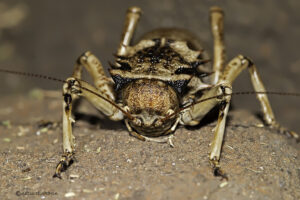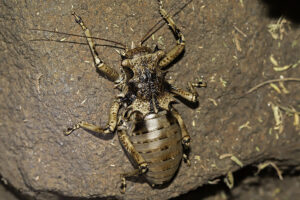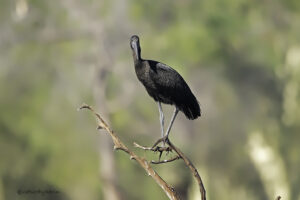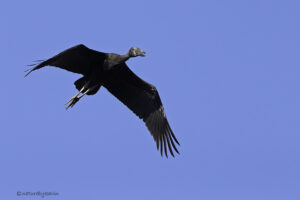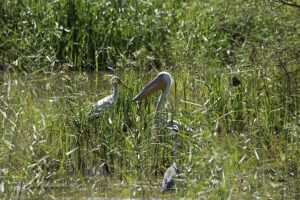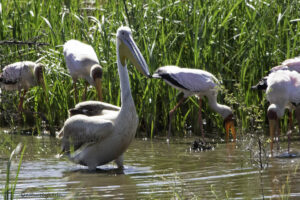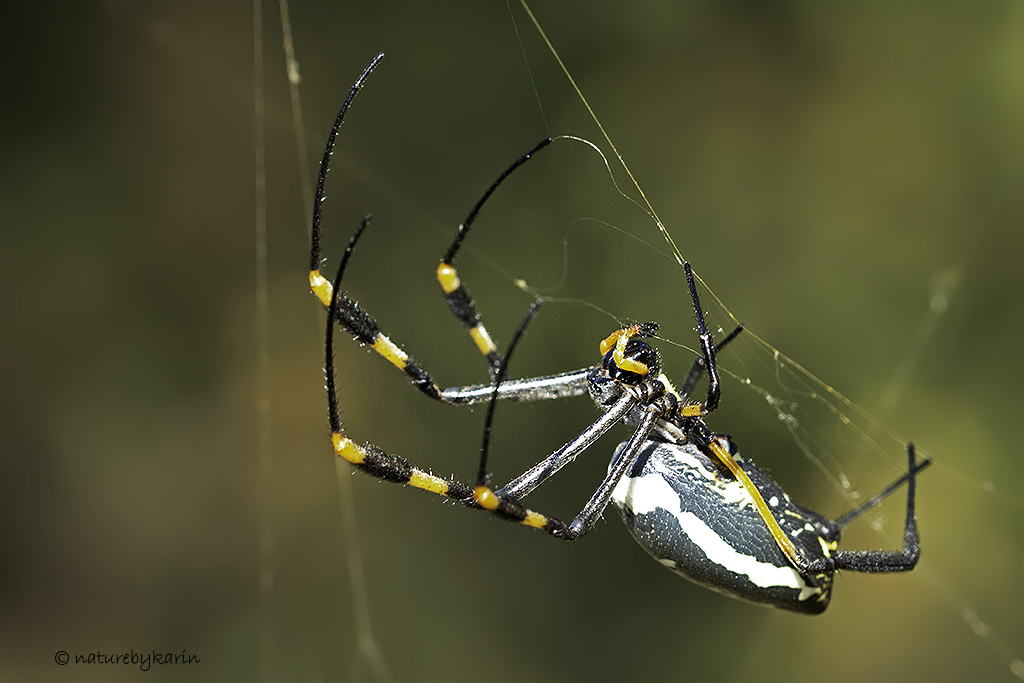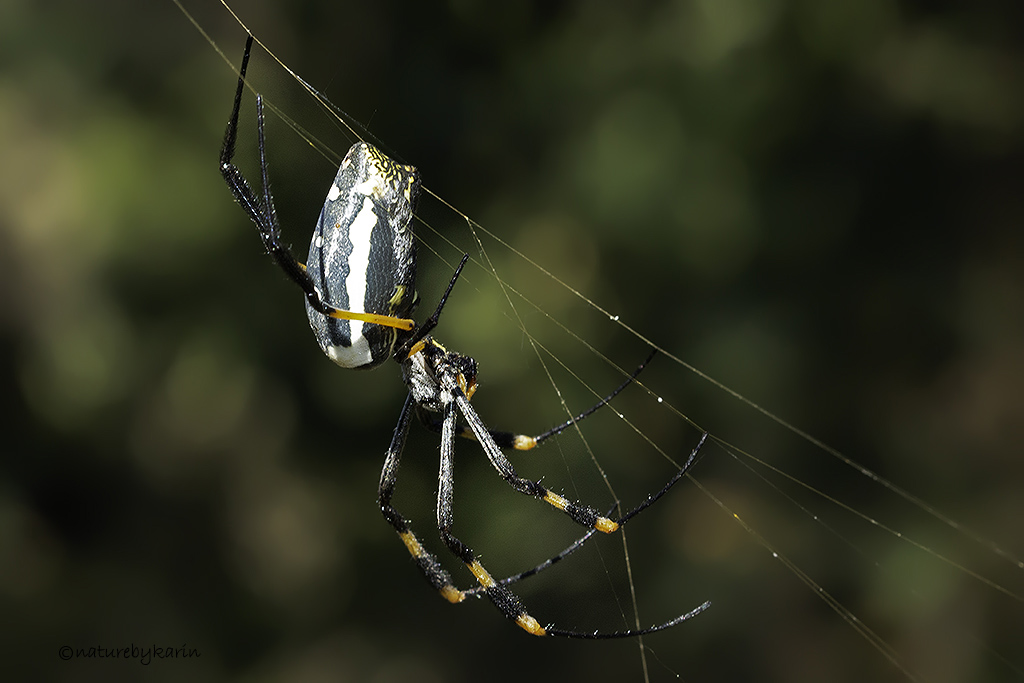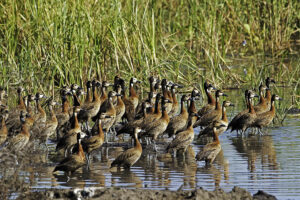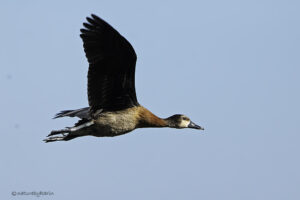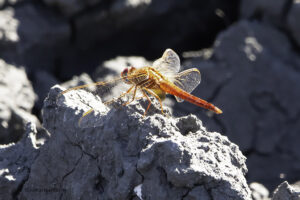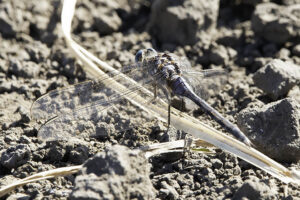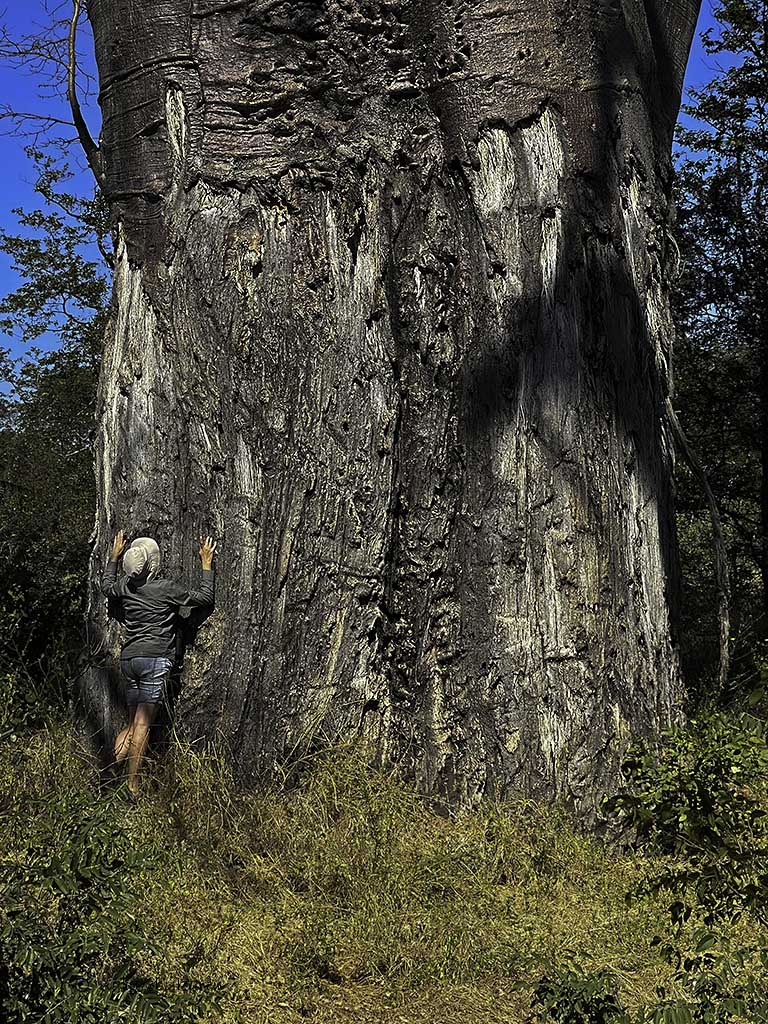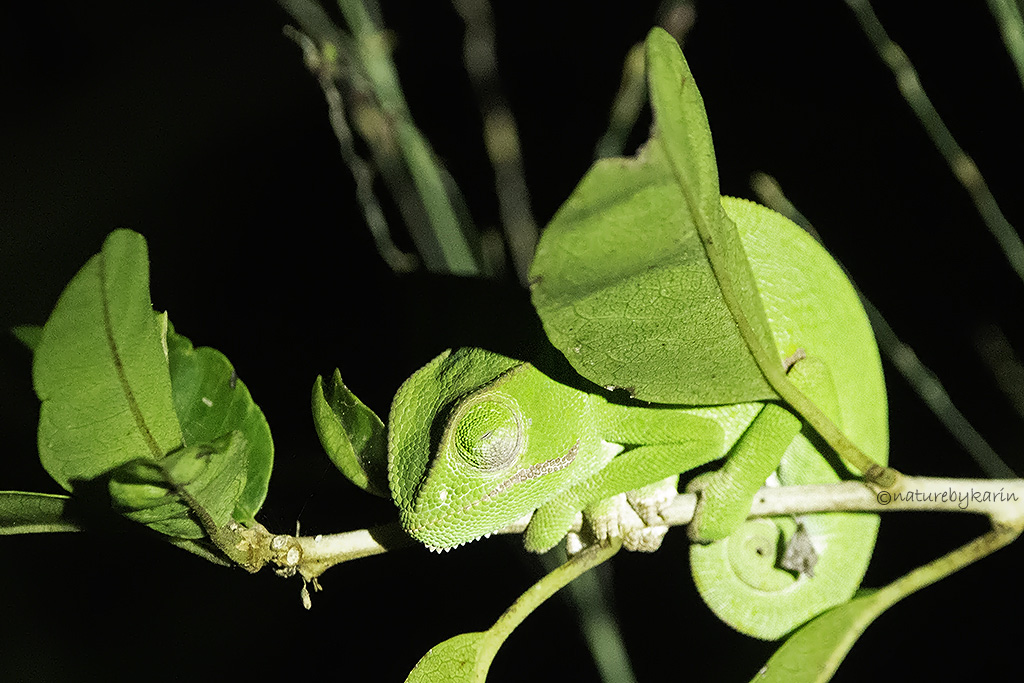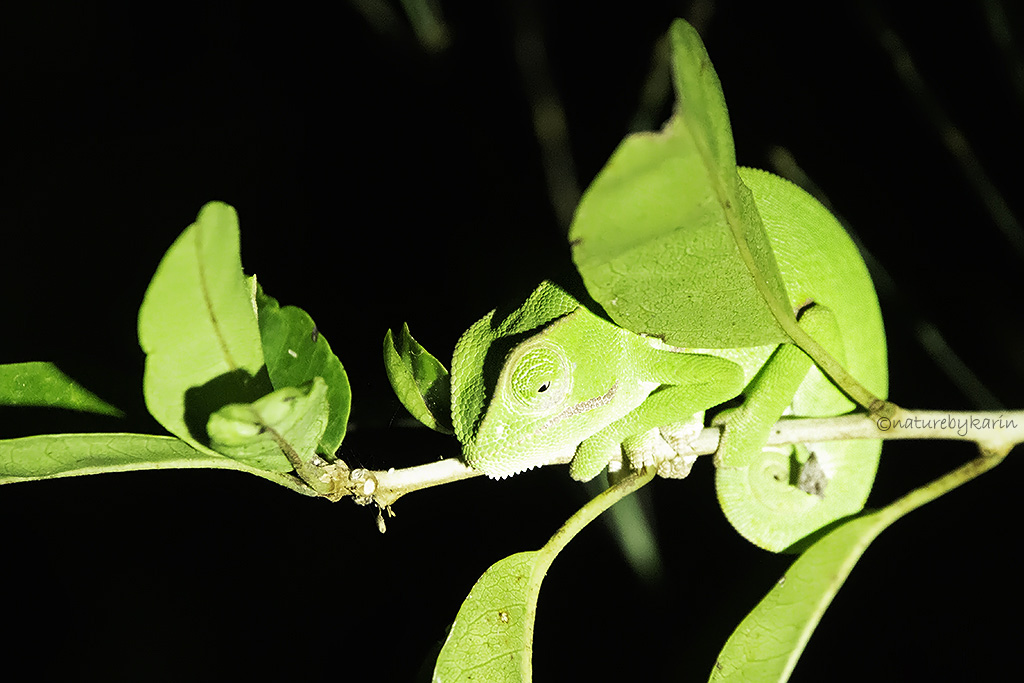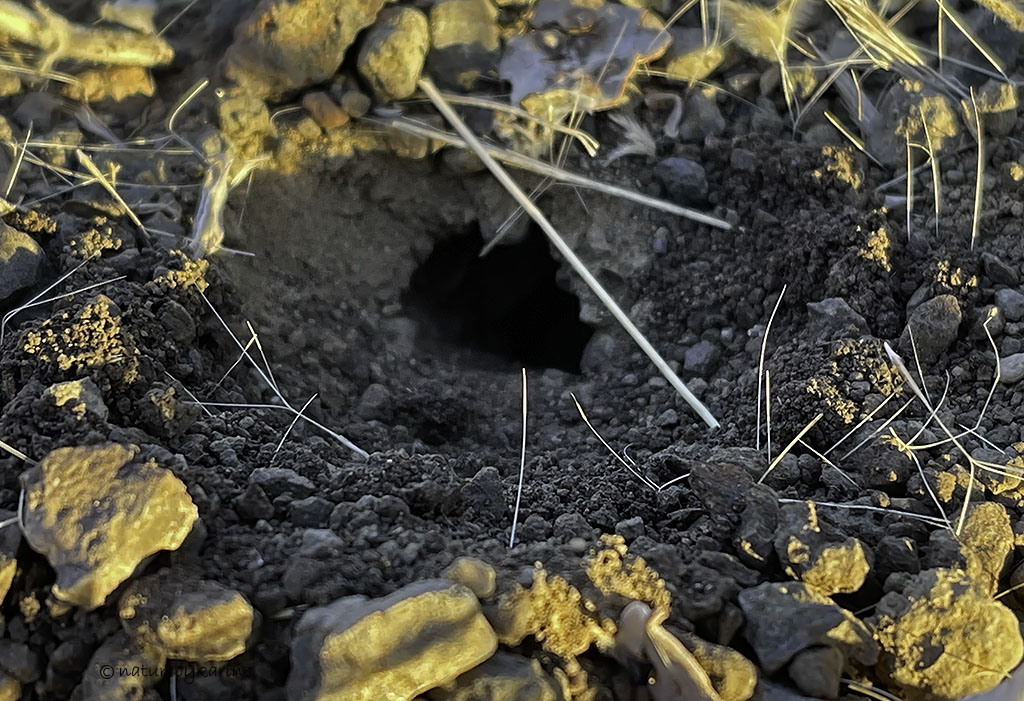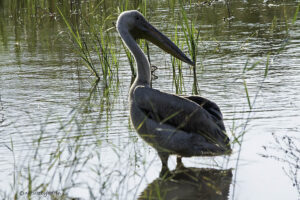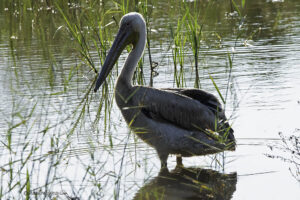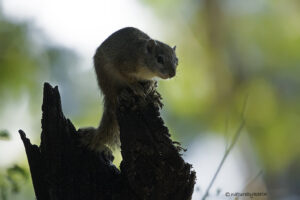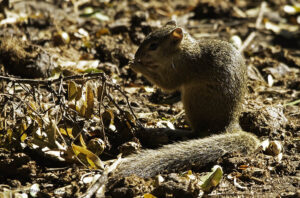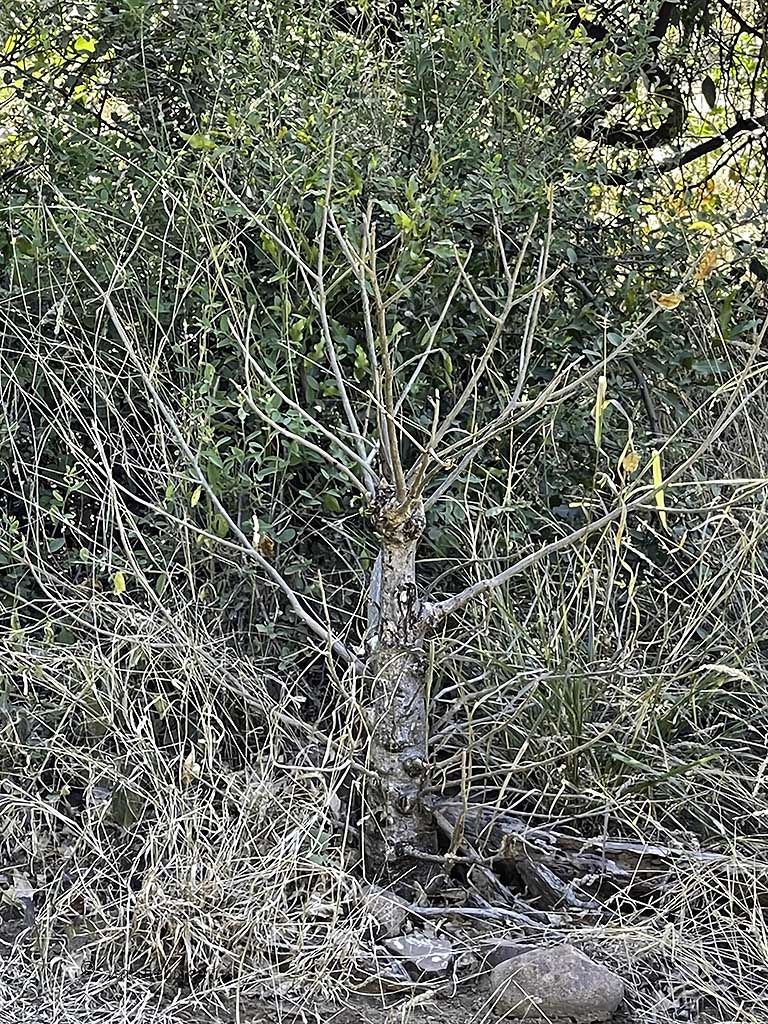I had exceptionally high expectations of the few days we would spend in the Makuleke Concession in the far North of Kruger. And I can say with confidence that all my expectations were exceeded a million times over.
Our group was scheduled to meet up with the Eco Training guides at the Pafuri Gate. Our luggage was loaded efficiently, and soon we were headed into the Park. After a few kilometers on the tar road we turned north onto a narrow dirt road. Everyone was in good spirits, and the drive was a lively experience as everyone got re-acquainted with each other. It was obvious that everyone was excited to be there.
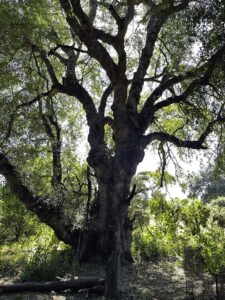 After about an hour we arrived at our destination. We were directed to our tents and the hustle and bustle of getting settled started. The Eco Training camp does not have electricity and there is absolutely no cell phone signal, a fact that I loved. The most beautiful Nyala tree was the main feature of the camp. The tents were spacious and very comfortable and all of them had adjoining bathrooms. The tents are placed far enough from each other along the perimeter of the camp to ensure each tent has sufficient privacy. A small fire break runs around the camp and beyond that was the wilderness – just meters from our tent. The rustic feel of the camp appealed to me immediately.
After about an hour we arrived at our destination. We were directed to our tents and the hustle and bustle of getting settled started. The Eco Training camp does not have electricity and there is absolutely no cell phone signal, a fact that I loved. The most beautiful Nyala tree was the main feature of the camp. The tents were spacious and very comfortable and all of them had adjoining bathrooms. The tents are placed far enough from each other along the perimeter of the camp to ensure each tent has sufficient privacy. A small fire break runs around the camp and beyond that was the wilderness – just meters from our tent. The rustic feel of the camp appealed to me immediately.
My main objective was to get my luggage in the tent as soon as possible so I could use the rest of the time before our safety briefing to explore the camp. I spotted a few birds around camp – Arrow-marked Babblers, Orange-breasted Bushshrike, Spectacled Weaver and a Dark-caped Bulbul. There was also a pair of very vocal Meve’s Starlings around. 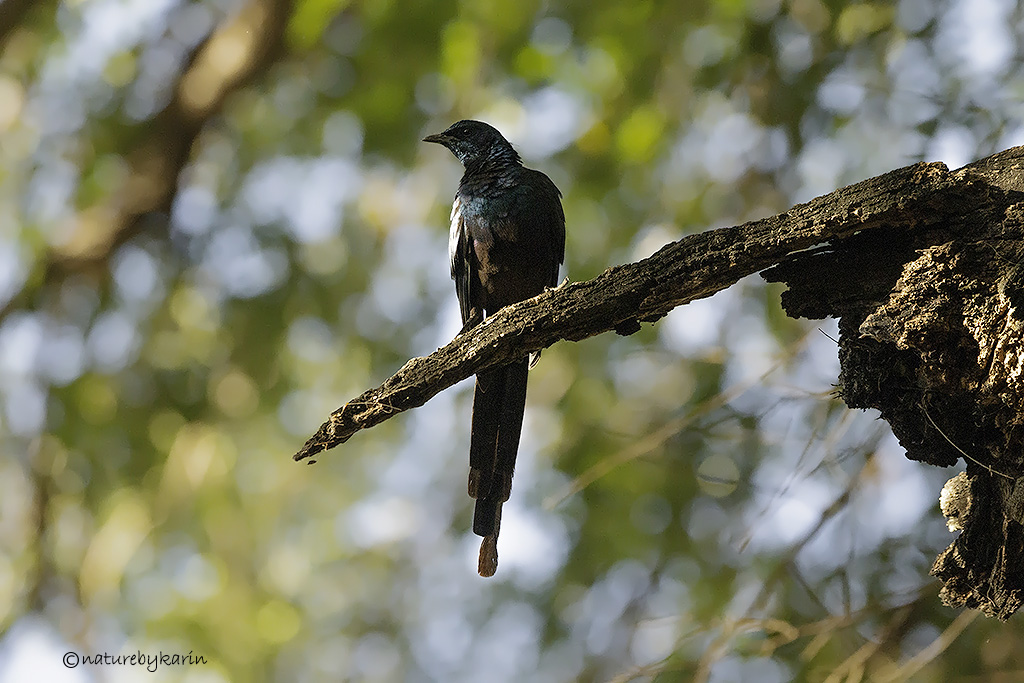
Birding continued with a Black-backed Puffback in the big Nyala Tree. I had not seen a Bennett’s Woodpecker for some time and was really happy to find this guy jumping about in the canopy of the Nyala Tree. 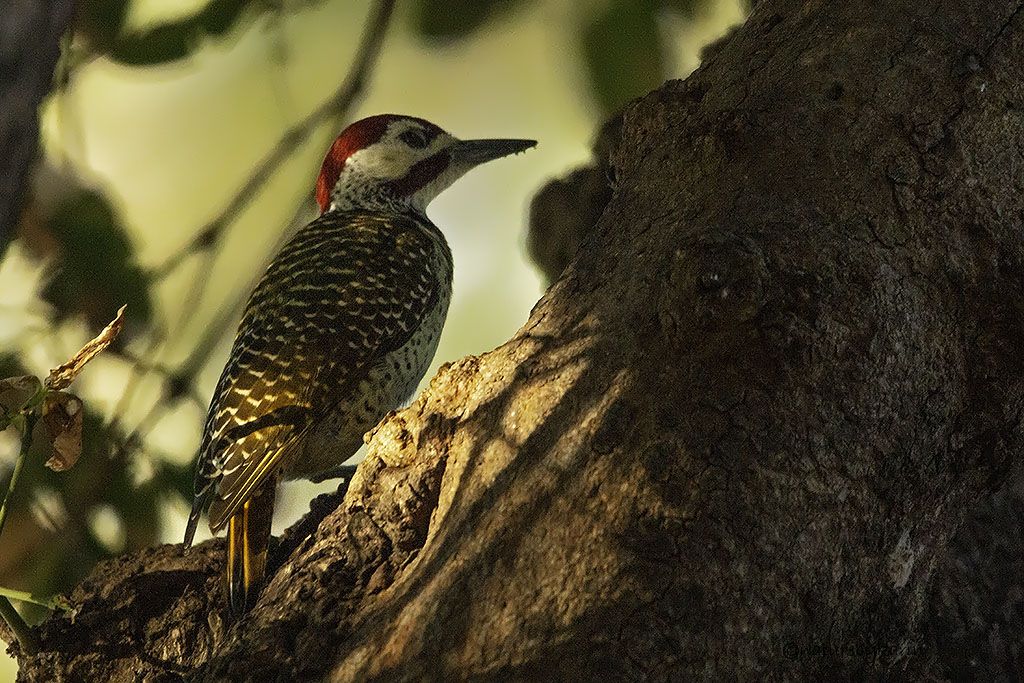
After while we met up in the dining area where Ross took us through the safety briefing. During the briefing we became somewhat distracted by an elephant that started browsing not too far from us.
We had a delicious dinner – the kitchen staff can really be commended for their incredible cooking skills.
Even though I had been awake since 03h30 that morning, I went for a short night walk in camp before going to bed. By now the generator had been switched off and the quiet was amazing. When you stay in the public rest camps you always have the “white noise” of other visitors, and that contributes a great deal to the atmosphere of an evening under the stars. But there is something to be said for being “off the grid” like we were – there was still the faint chatter of some of our group, but with a darkness surrounding me that I could almost feel, it was a very different bug hunting experience.
I did not find much that first evening other than a pretty Box Kite Spider – a new species for me.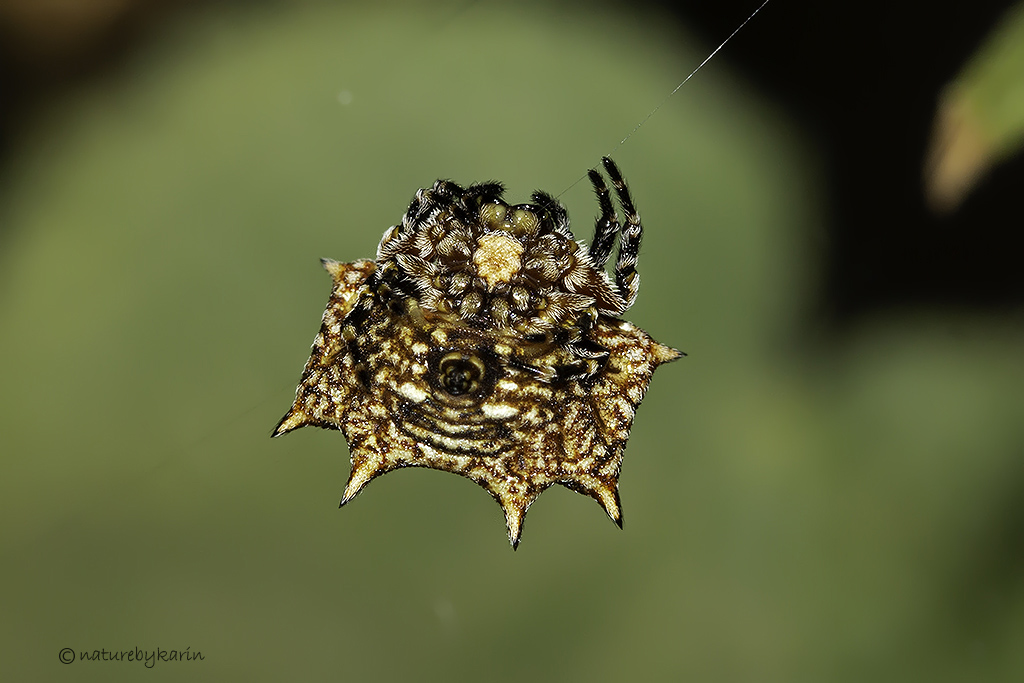
And this interesting Armoured Cricket – very different to the ones I have seen in the past.
Another member of our group also went for a night-time walk, but he found a few other creatures. He managed to find a few sleeping birds – a White-throated Robin-Chat, a Burnt-necked Eremomela and a Long-billed Crombec. The little Crombec was so fast asleep that he could move a leave next to the little bird with his hand without waking the little guy! It was so sweet to see these sleeping little birds.
But the long, exciting day started to take its toll, and with the knowledge that the drums would wake us at 05h00 the next morning, I headed to bed, excited to find out what the next day would bring.
I was woken at about three in the morning by the very loud laughter of Hyenas. It was a beautiful noise and I lay awake listening to them for a while before drifting off to sleep again.
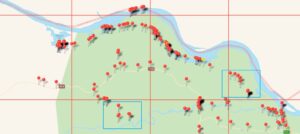 The next morning everyone met for a quick coffee before leaving at about 06h00. The lively chatter was a clear I indication that everyone was looking forward to the day. Our main destination for the morning was Riedbok Vlei – in the Eastern section of the Concession, and in the afternoon, we would visit Lanner Gorge (one of my main reasons for coming on this trip) in the south-western region of the Concession.
The next morning everyone met for a quick coffee before leaving at about 06h00. The lively chatter was a clear I indication that everyone was looking forward to the day. Our main destination for the morning was Riedbok Vlei – in the Eastern section of the Concession, and in the afternoon, we would visit Lanner Gorge (one of my main reasons for coming on this trip) in the south-western region of the Concession.
Birding started as soon as we left camp. Highlights included a Harlequin Quail flying up in front of our vehicle, a Black-headed Oriole, Martial Eagle, a White-crowned Lapwing and a Scarlet-chested Sunbird that was quite happy to show off his beautiful colours.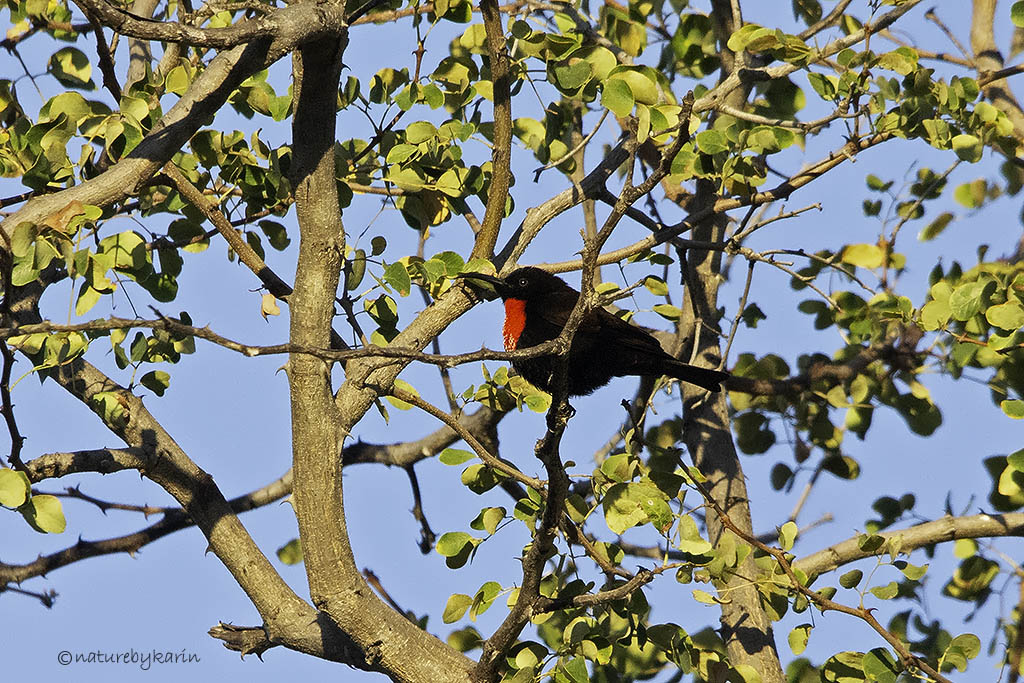
The most excitement however came from a Senegal Coucal. He made it very difficult for us to photograph him, and post the trip caused some debate as to the ID. But in the end the consensus was that it was indeed a Senegal Coucal, and everyone was very happy to add this bird to their lists, a lifer for many, including myself. A great start to the day’s birding.
We continued on our way. Birds included many of Kruger’s regulars – Southern Red and Yellow-billed Hornbills, Green-winged Pytilias, Little Bee-eater, Double-banded Sandgrouse and Mosque Swallows.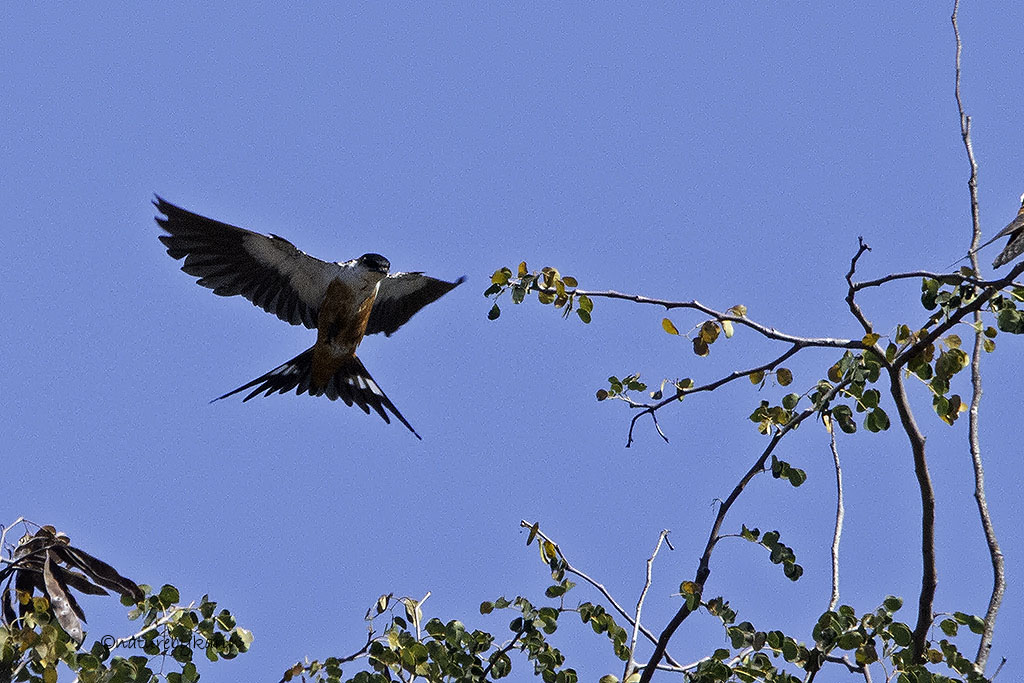
At one of our stops along the way there was a pair of Namaqua Doves.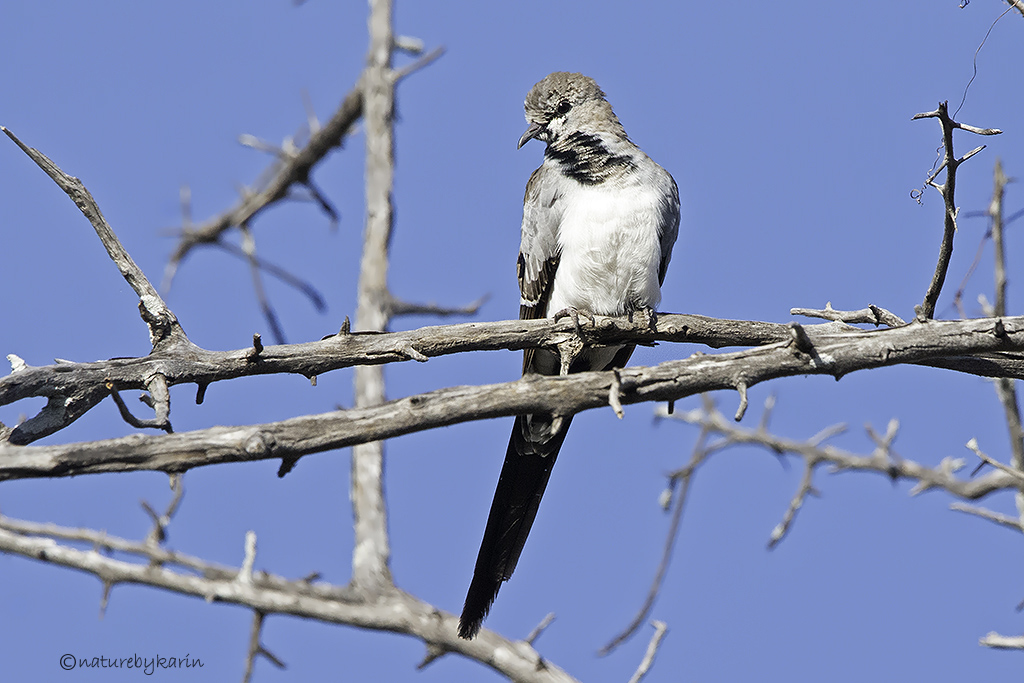
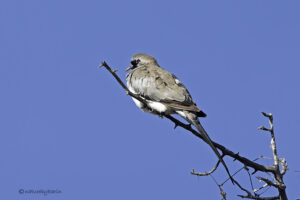
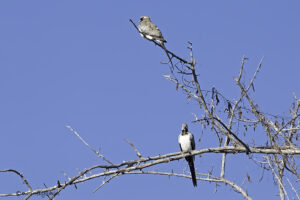
An Armoured Cricket was watching us from the grass. 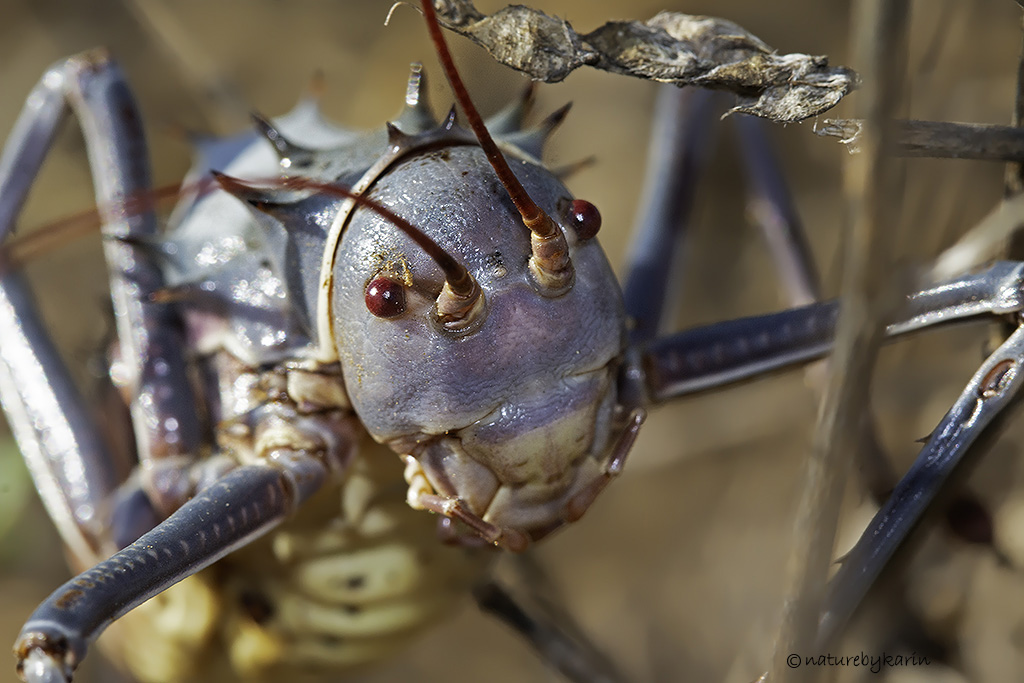
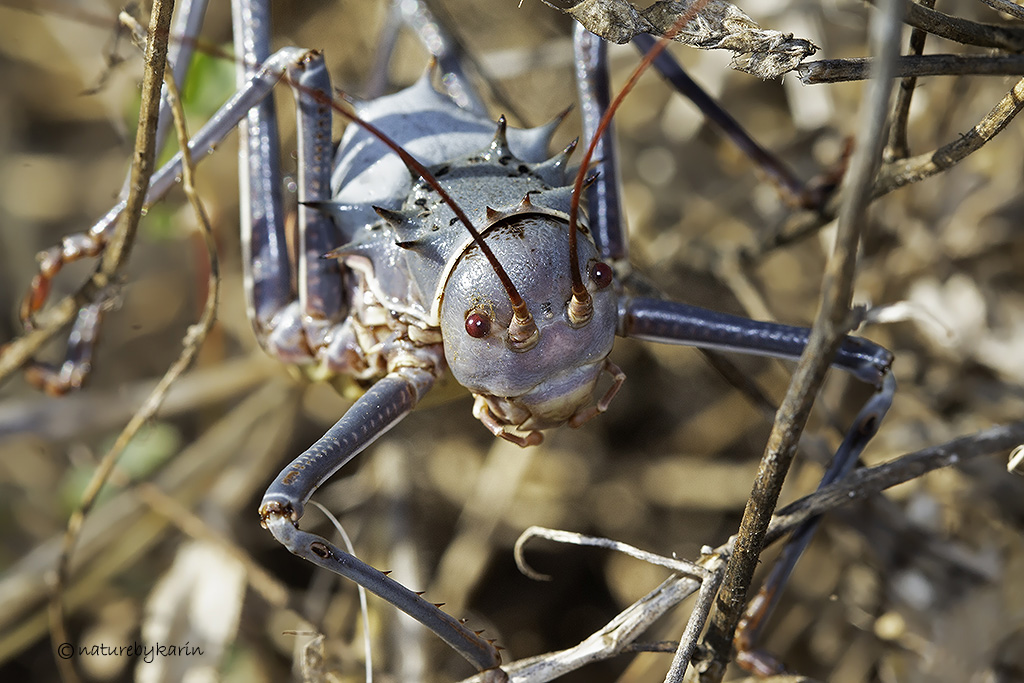
I just loved this Shepherd’s Tree.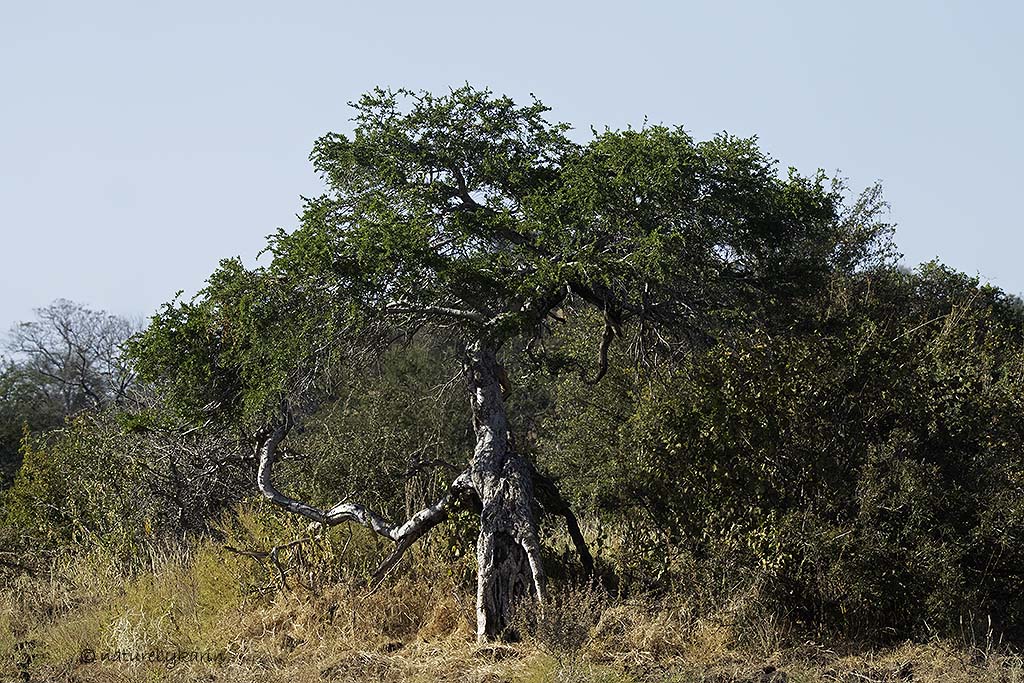
And of course, I could not resist my favourite Tree. 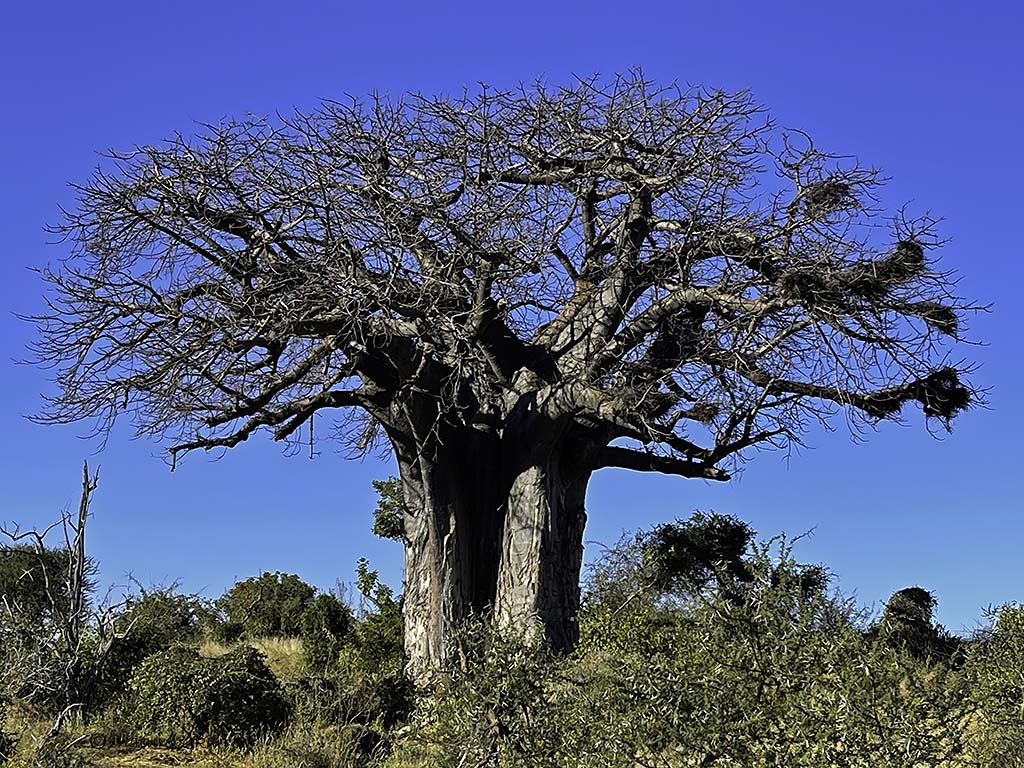
Finally, we arrived at our destination. And this where words fail me. A large pan ensured that the Fever Tree forest was surrounded by water.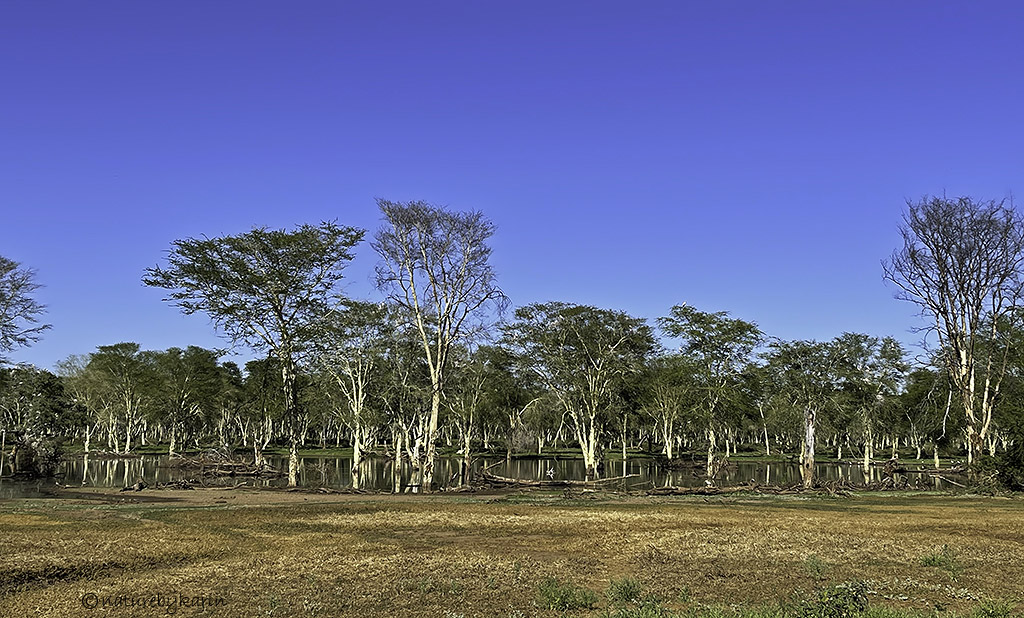
Every tree contained multiple nests. The bird activity and the sounds they made were just incredible – Yellow-billed Storks and Open-billed Storks were everywhere.
The Yellow-billed Storks did low fly-bys and you could hear the whooshing sound of their wings above your head. 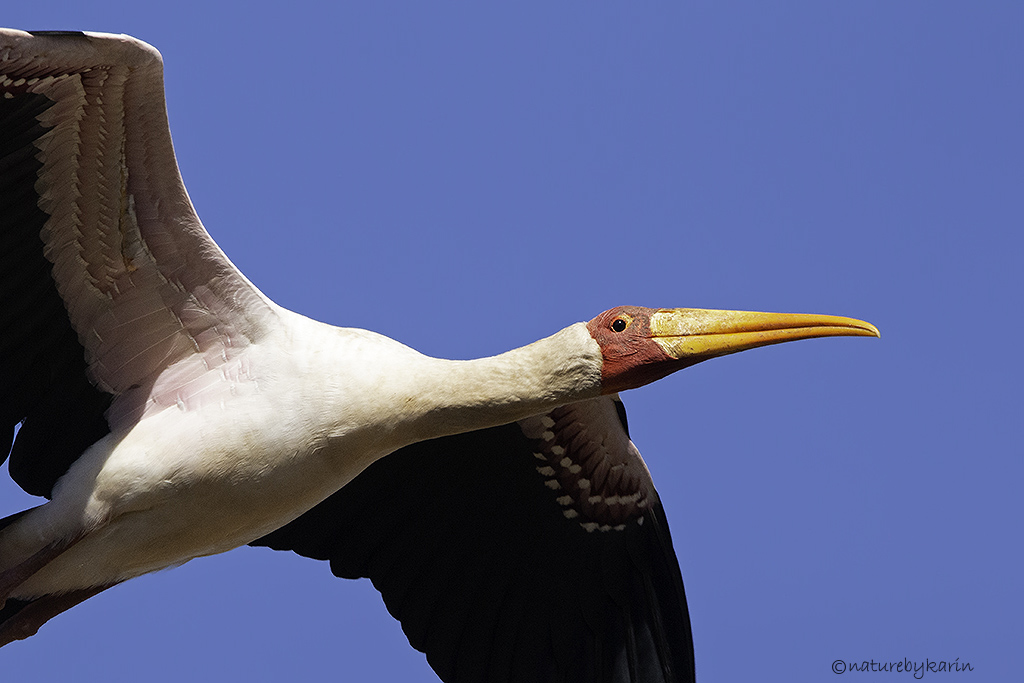
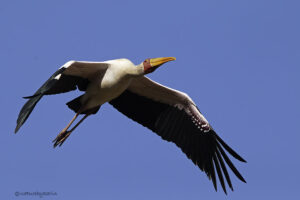
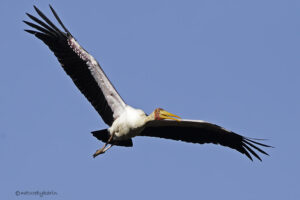
Duncan mentioned that he counted more than 50 nests. Youngsters of various ages occupied the nests. 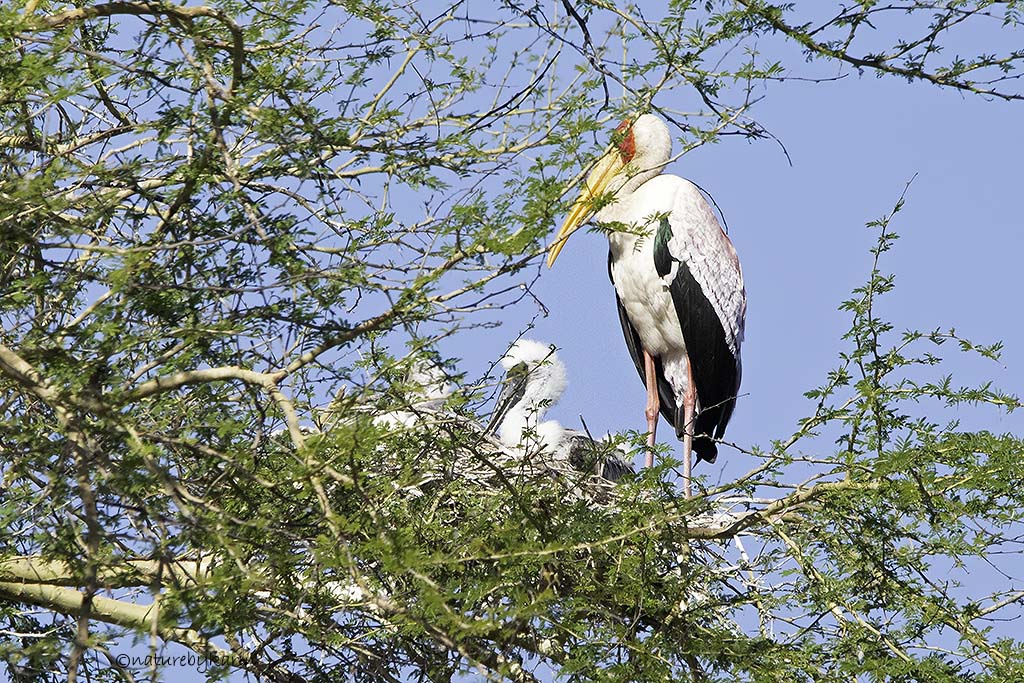
Adults continued their nest maintenance.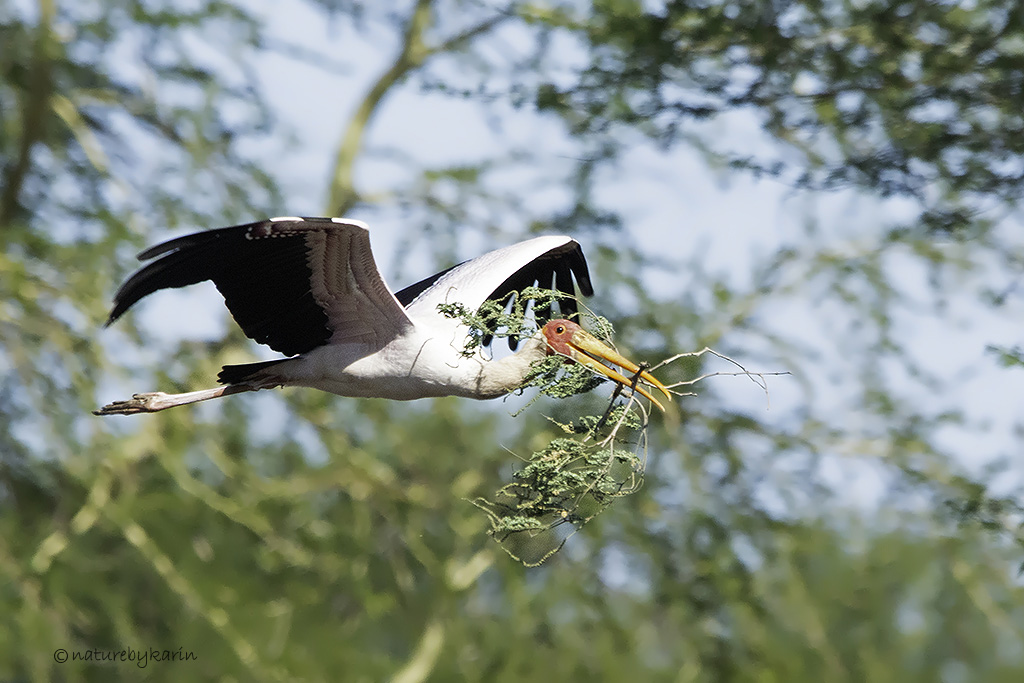
A White-crowned Lapwing was surprisingly vocal as he flew past and then continued to shout at us from a little distance away.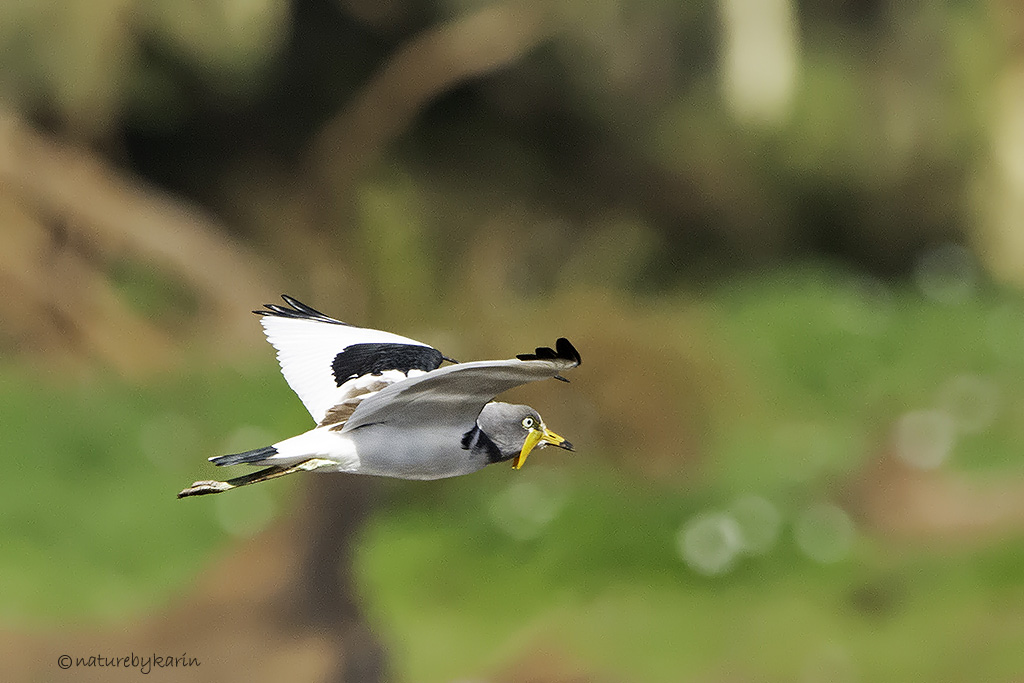
I saw Hamerkop, Black-winged Stilt, Pied Kingfishers and a Malachite Kingfisher, a pair of young Black-crowned Night Herons, an African Pied Wagtail and an African Green Pigeon to list a few of the birds. Crocodiles basked on the far side of the pan while a Grey Heron was hunting in the shallows.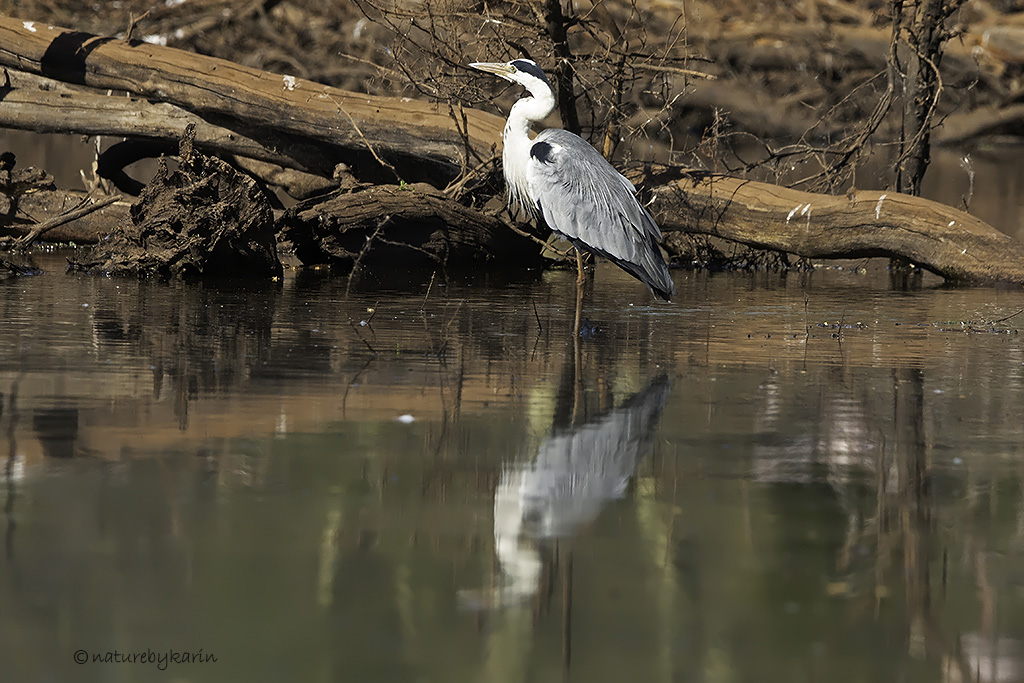
And then there were the trees.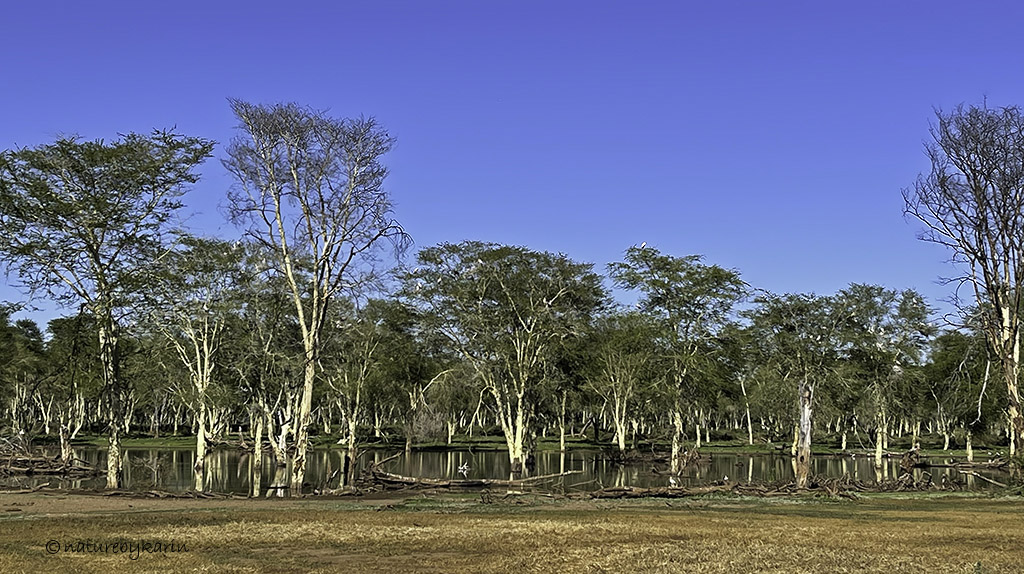
The scene was completely breath-taking and left me speechless. It was without a doubt one of the most beautiful places I had ever seen. I found a log and sat down for quiet moment to take in the incredible scene and sounds.
It was so magical, I even forgot to get coffee! 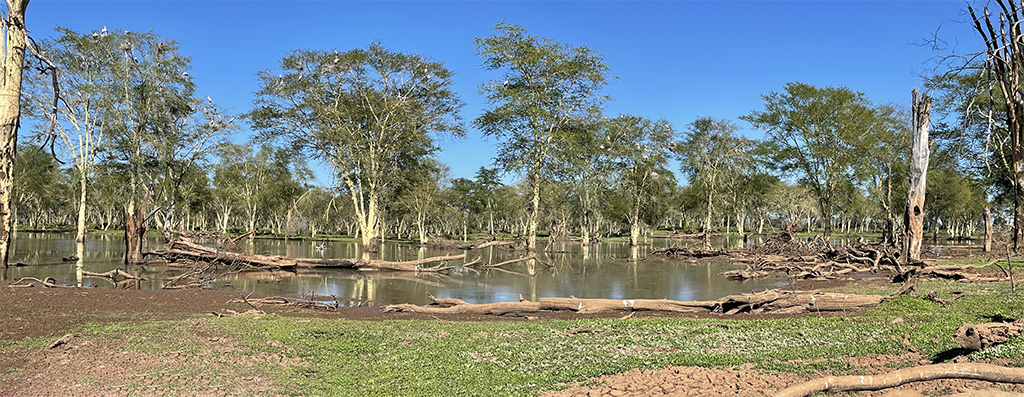
While I was sitting on the log, I noticed a number of smaller creatures, and I swapped the long lens for the macro lens. There was a large millipede.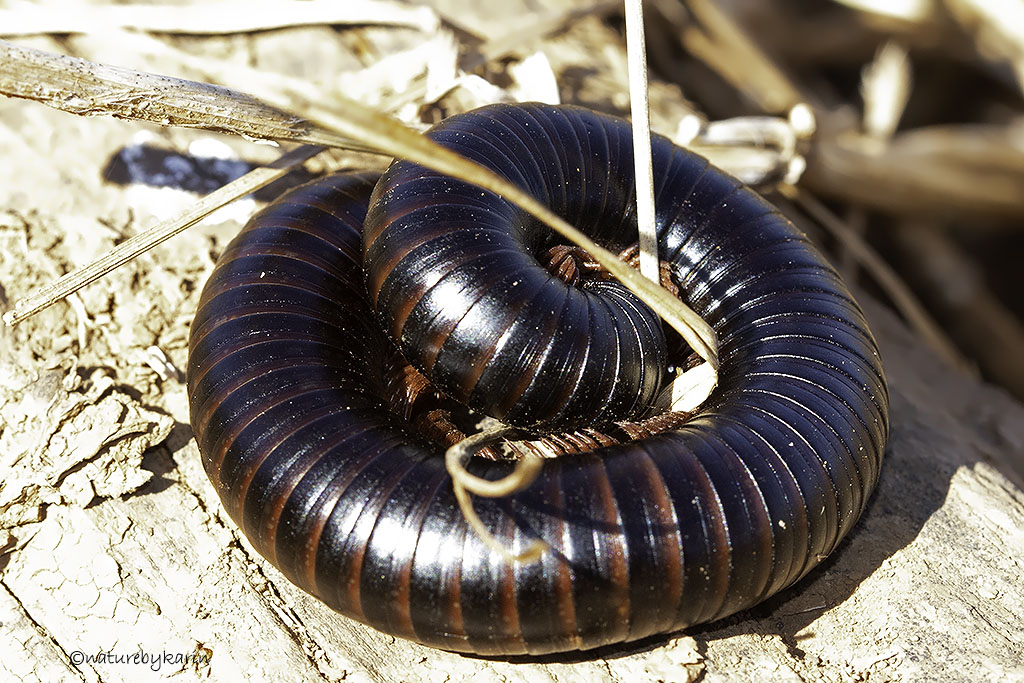
There were also lots of Southern Banded Groundling Dragonflies around.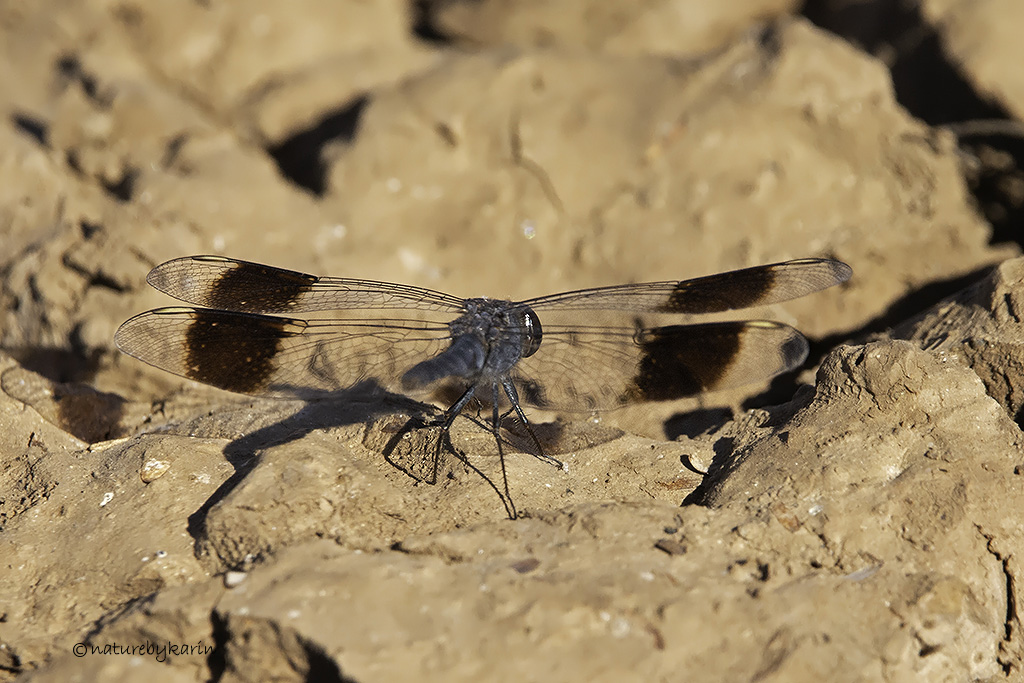
I was able to add the first of five new butterflies to my list – a Dancing Telchinia.
All too soon it was time to leave this wonderful place.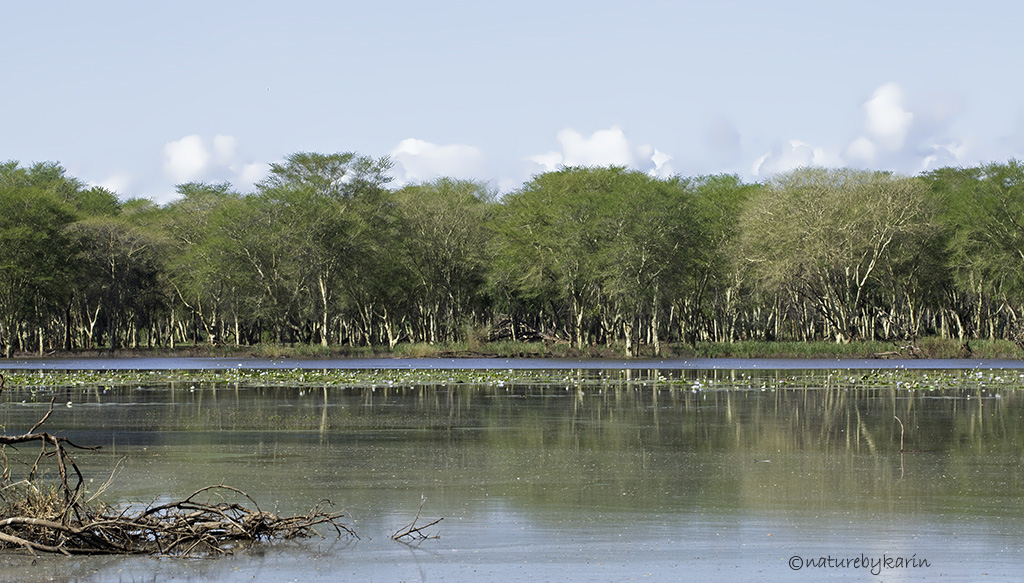
I felt completely overwhelmed by what I had seen and heard. For a while I just sat quietly, thinking about the morning and how I felt. It was only our first morning of birding, and already I was completely elated by the experience.
On the trip back we stopped every now and then for any birds that were new to our day list. Suddenly Ross slammed on the brakes and pointed upwards – Mottled Spinetails were mixed with the Palm Swifts above the car. I am still amazed that he was able to spot them with the naked eye while driving. He explained the shape and size as well as the difference in flight patterns compared to other swifts, and then it was reasonably easy to pick up the bird through the binoculars. The tail was longer than I thought it would be, but still very distinctive. As with about half my lifers on this trip I only managed a few blurry “record” shots, but I was very happy with some great views.
A little further we reached another large pan. Earlier the day the pan was fairly quiet with only a few Egrets and Grey Herons around. Now there was more activity with quite a few Yellow-billed Storks foraging. And then I saw a head with a very distinctive shape that looked very out of place and was completely unexpected.
A Great White Pelican! The Storks took off and not wanting to be left behind, the large bird followed.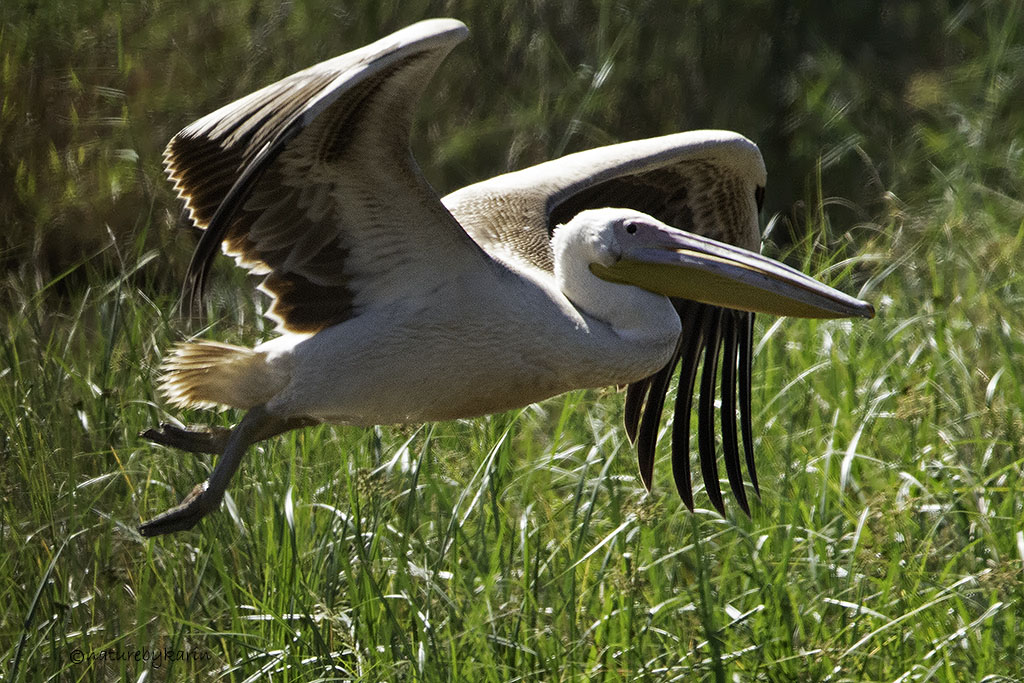
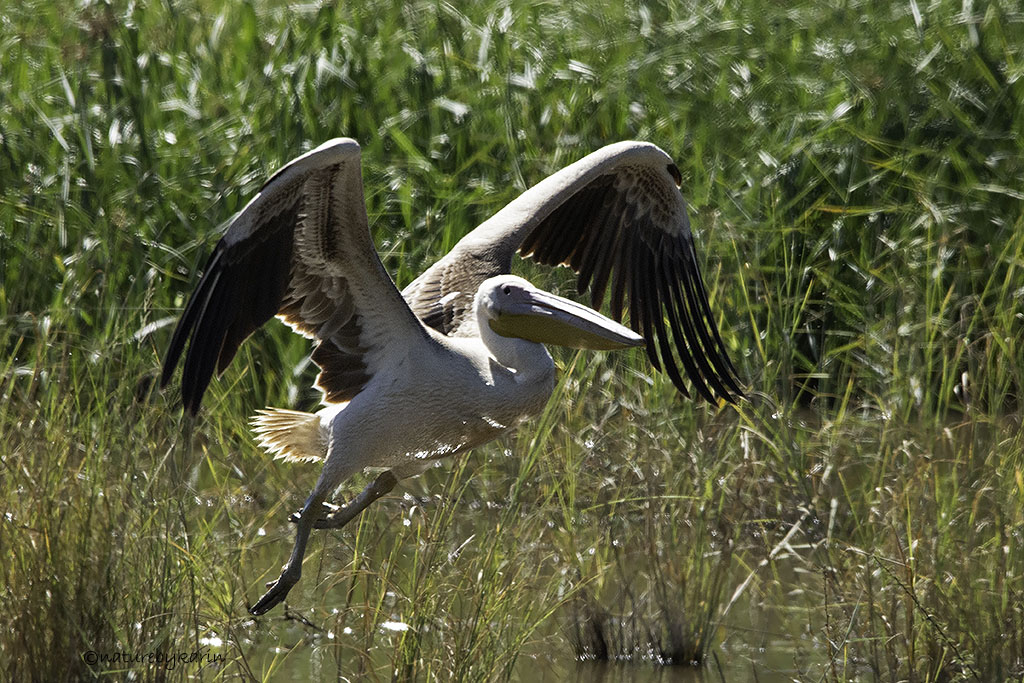
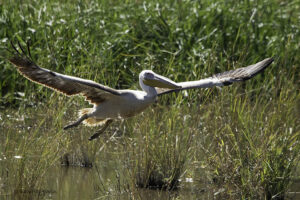
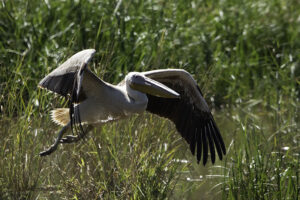
I have always wanted to see one in Kruger, and this was very much the cherry on top of what had already been an amazing morning.
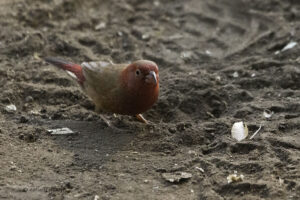 We arrived back at camp and had a delicious brunch. We could all relax for a few hours until it was time to leave for Lanner Gorge. I walked around camp for a bit. I found some Red-billed Firefinches.
We arrived back at camp and had a delicious brunch. We could all relax for a few hours until it was time to leave for Lanner Gorge. I walked around camp for a bit. I found some Red-billed Firefinches.
A huge female Golden Orb Web Spider had made her home in camp.
It was very hot, and I relaxed in the dining area until it was time for us to leave for our afternoon drive. Just before we reached the tar road, we spotted a skittish kudu bull with fantastic horns and a leopard tortoise. Shortly after turning onto the tar road a Shikra flew past and landed in a tee in front of us, but just too far for a good photo.
Then we turned onto the dirt road south, and of course I could not ignore this beauty.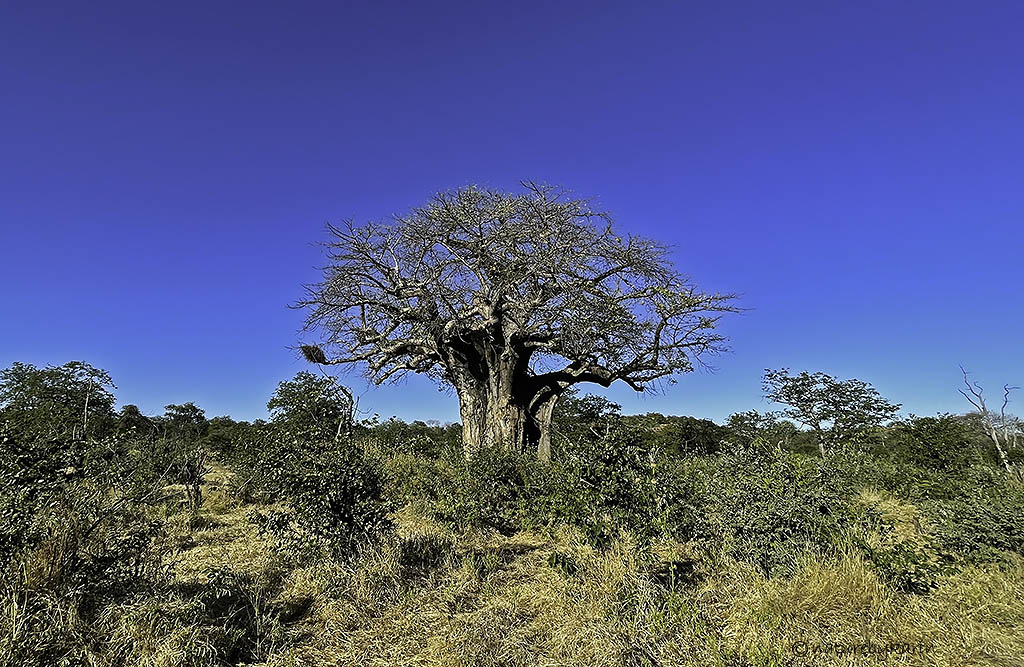
And then another lifer – a stunning Dickinson’s Kestrel. He posed beautifully for us.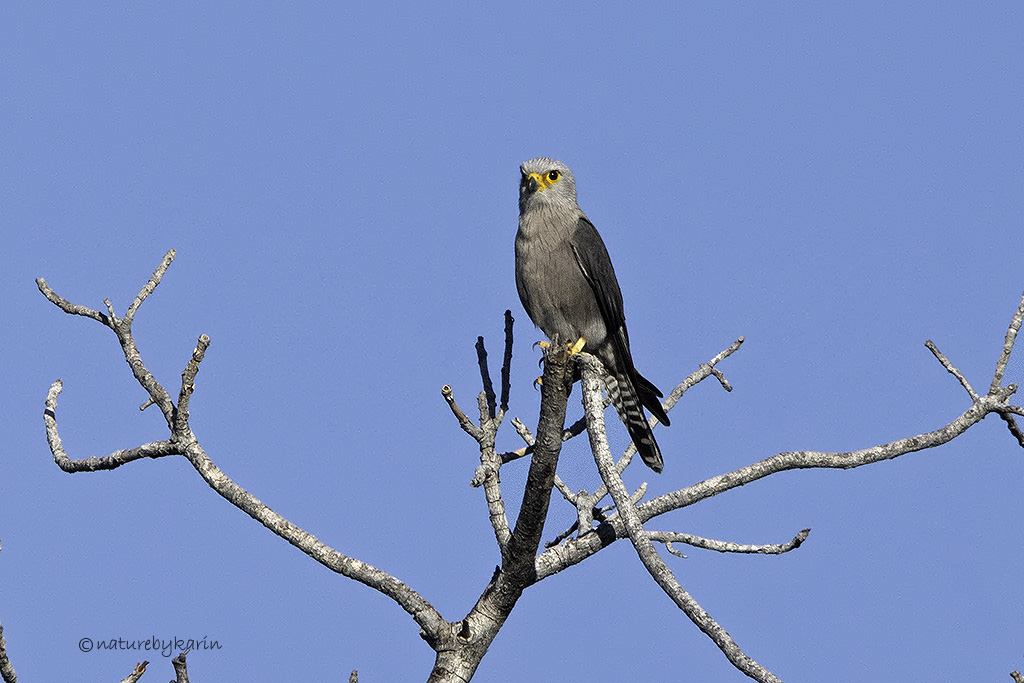
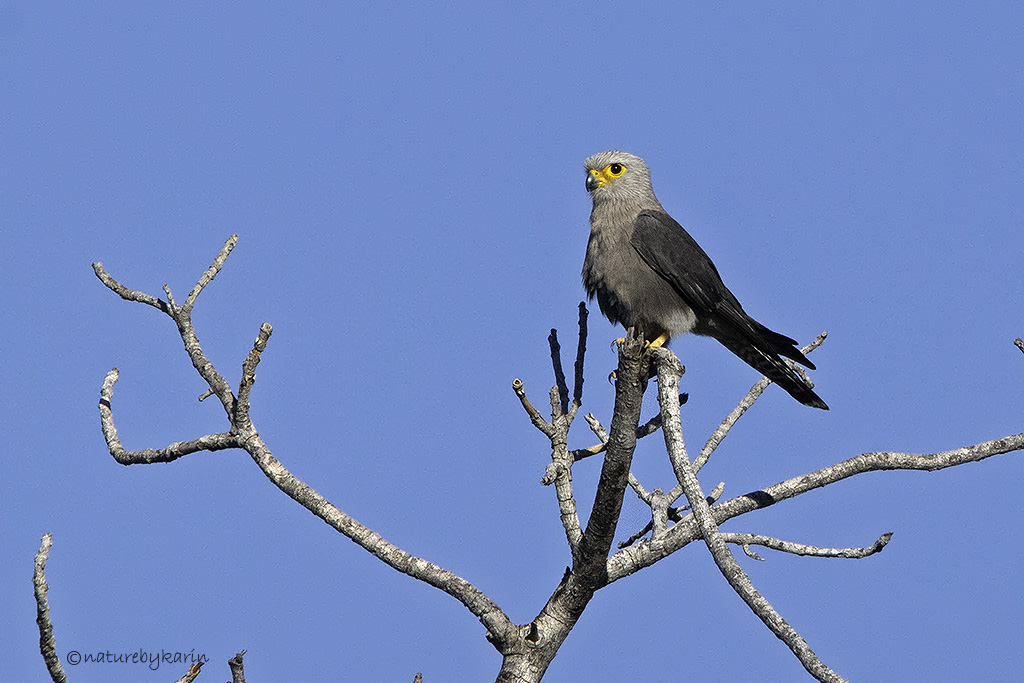
This Indigo Bird and Cut-throat Finches made for a pretty picture against the clear blue sky.
The bumpy, twisty road eventually lead us to Lanner Gorge. A quick walk through a forest and a short climb to the lookout point, and I lost my breath for the second time that day.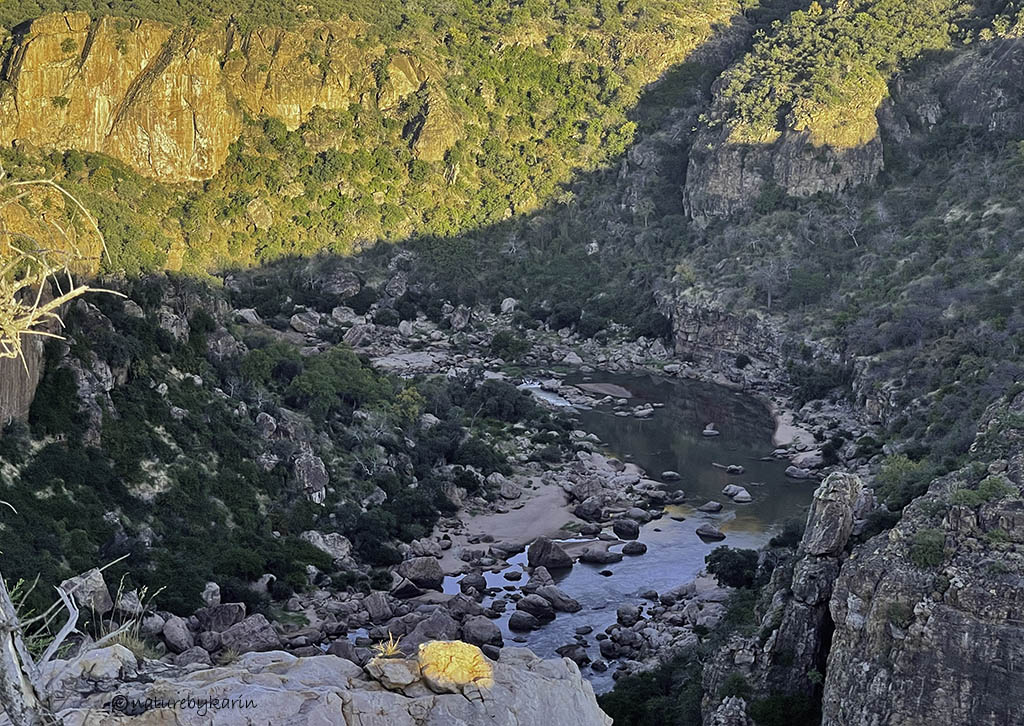
It was everything I had expected and more. From the minute I had seen photos of this place I had wanted to come here. The sun was setting, and the gorge was already cast in shadows. The sky beyond was the most beautiful blue and pink.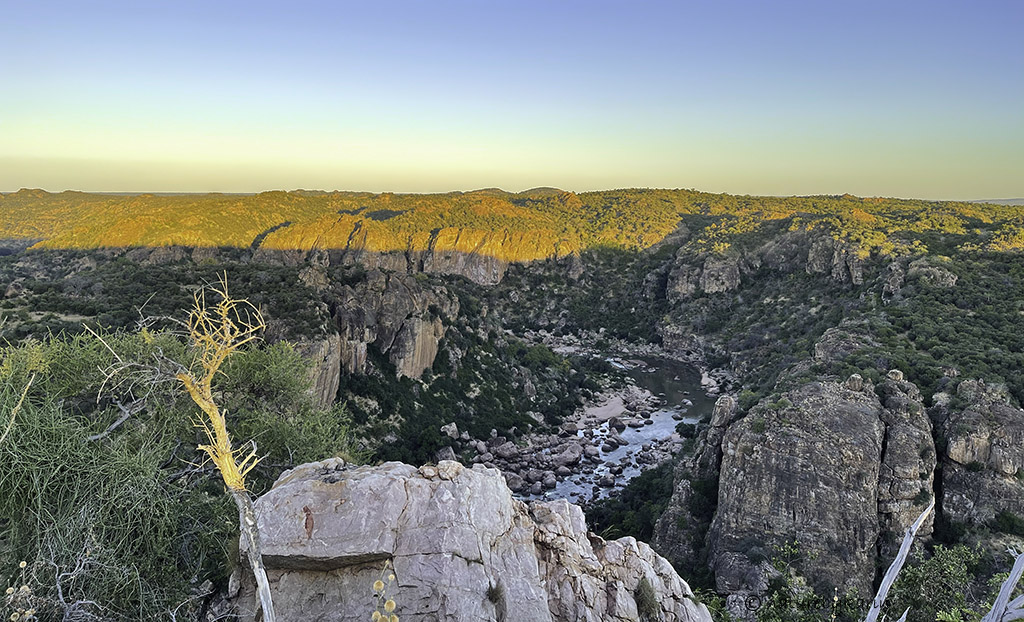
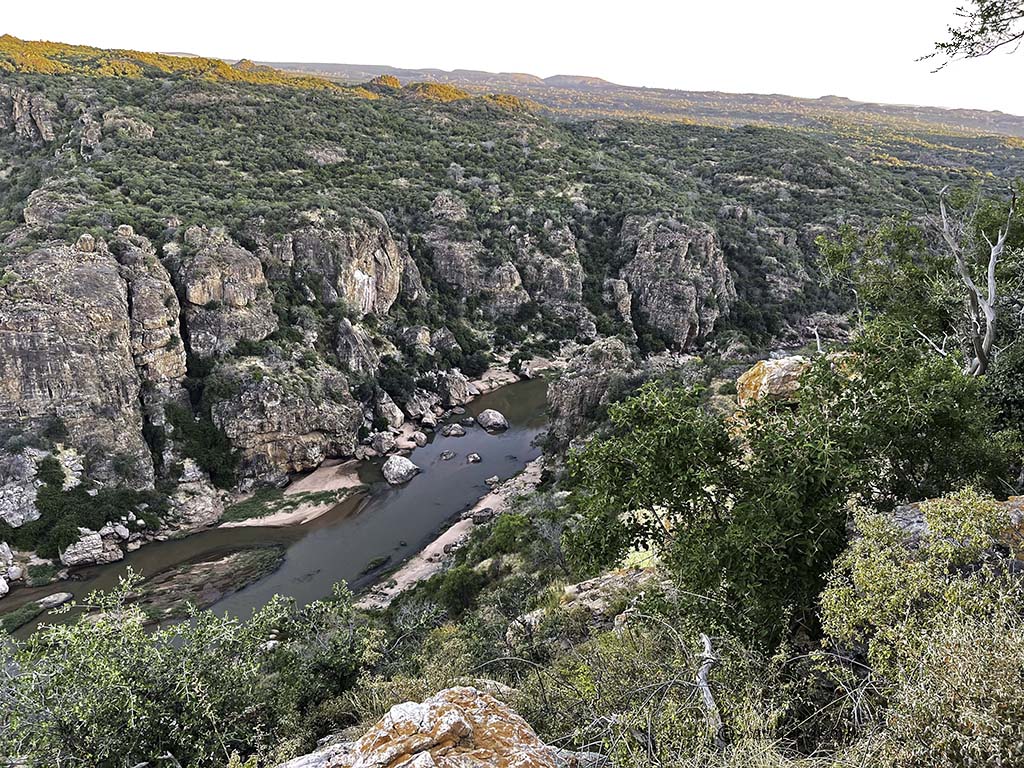
On the other side of the gorge was a little koppie and we could just make out the Verreaux’s Eagle perched next to it, another Kruger bird that had been high on my wish list. A little bit to the west of the Eagle was a Baobab forest.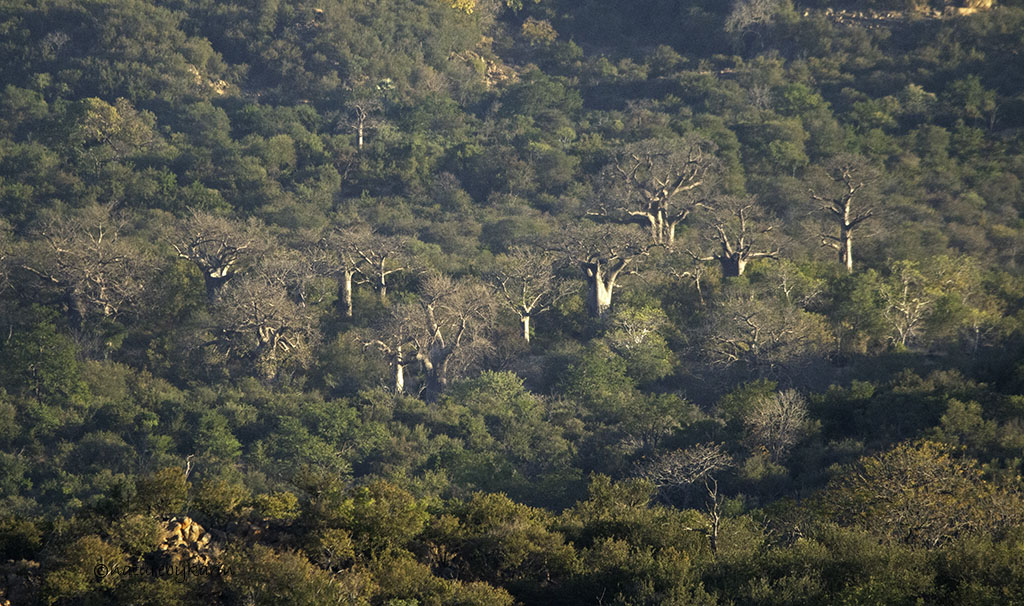
I found a spot a few meters down from the main look out point to sit quietly for a few minutes. What a day this had been.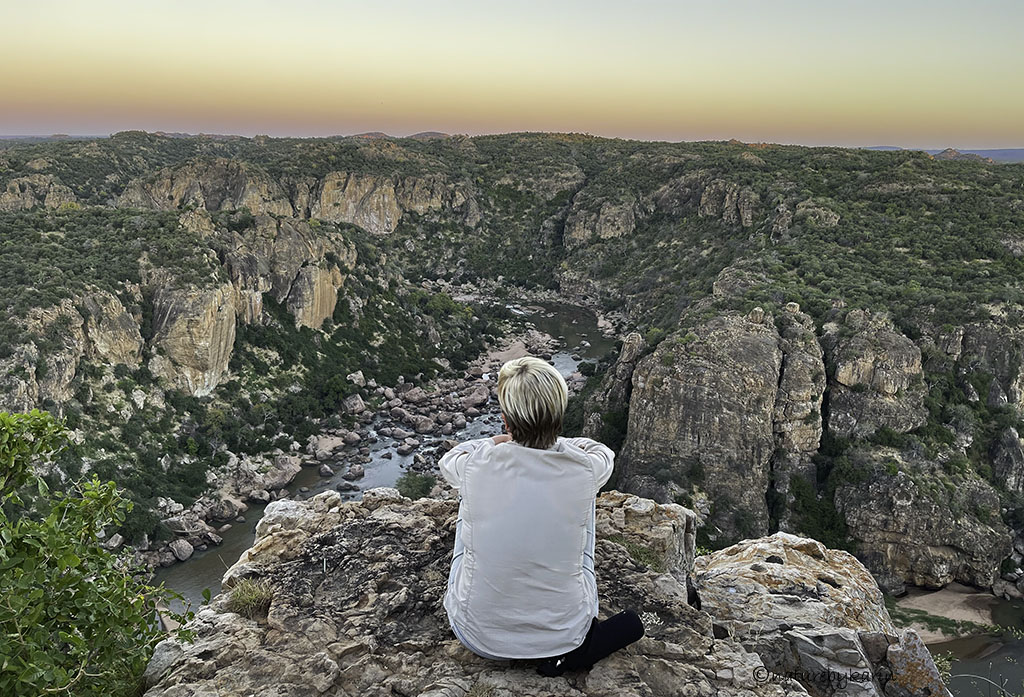
Sadly, we had to leave as we needed to make our way down before it was too dark.
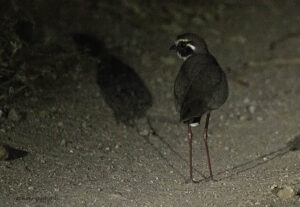 The sun set quickly, and soon we were driving in complete darkness. We stopped to admire the perfectly straight line formed by Venus, Mercury and the sliver of the Moon. We also stopped once or twice to listen for owls and night jars. While we did not hear any, the sound of the silence in the dark bush was just as good. Just before camp we found a Bronze-winged Courser in the road.
The sun set quickly, and soon we were driving in complete darkness. We stopped to admire the perfectly straight line formed by Venus, Mercury and the sliver of the Moon. We also stopped once or twice to listen for owls and night jars. While we did not hear any, the sound of the silence in the dark bush was just as good. Just before camp we found a Bronze-winged Courser in the road.
We were treated to another tasty dinner. I really think the ladies who prepared the meals would win one of those cooking competitions hands down.
Saturday morning was another early start. For the second night in a row the hyenas had a stand-up comedy night and I could hear their raucous laughter in the early hours of the morning.
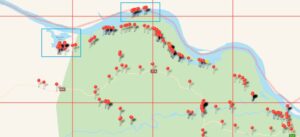 Today we would head to the most western end of the Concession to Banyini pan, or as Duncan calls it – “The Centre of the Universe”. And our afternoon outing would be sundowners on the banks of the mighty Limpopo River in the northern most point of the Park.
Today we would head to the most western end of the Concession to Banyini pan, or as Duncan calls it – “The Centre of the Universe”. And our afternoon outing would be sundowners on the banks of the mighty Limpopo River in the northern most point of the Park.
It was a fairly chilly morning, but I was too excited to be bothered by the cold too much. Shortly after leaving camp we had a distant sighting of an African Harrier Hawk.
It really pays to be on bird trips with expert birders. Just like Ross amazed me the previous day with his bird spotting skills, Duncan did the same by spotting one of Kruger’s smallest birds – a Grey Penduline Tit. I am not even going to pretend that I have the skills to find this little guy on my own. But I was extremely grateful for his assistance to locate my fourth lifer of the trip.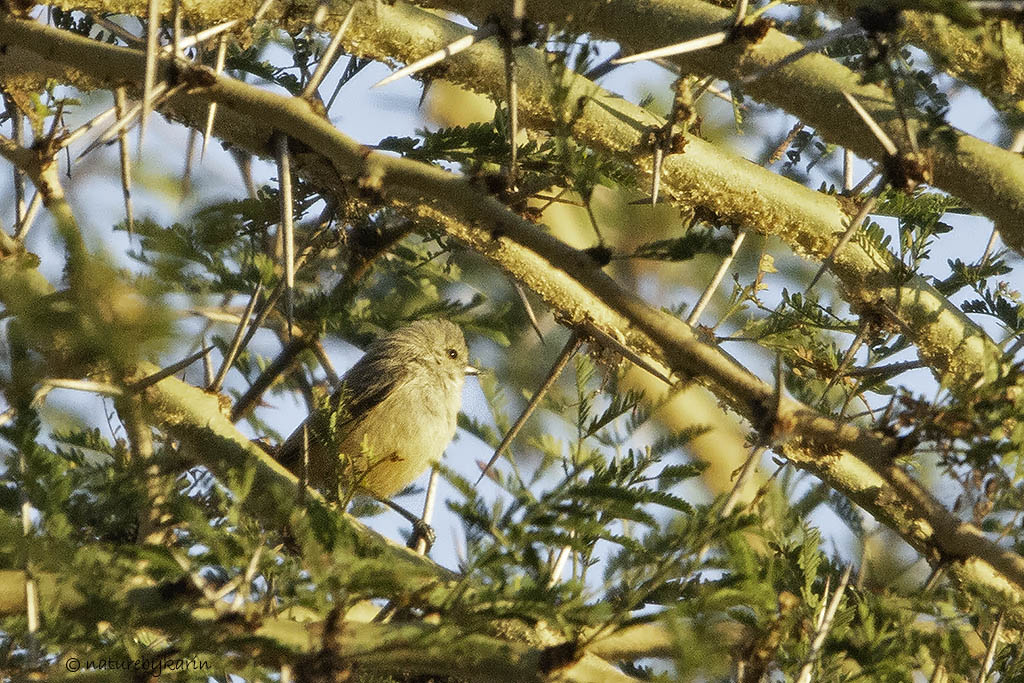
We reached a section with a lot of Lala Palms on either side of the road. A small herd of buffalos eyed us suspiciously before trotting off.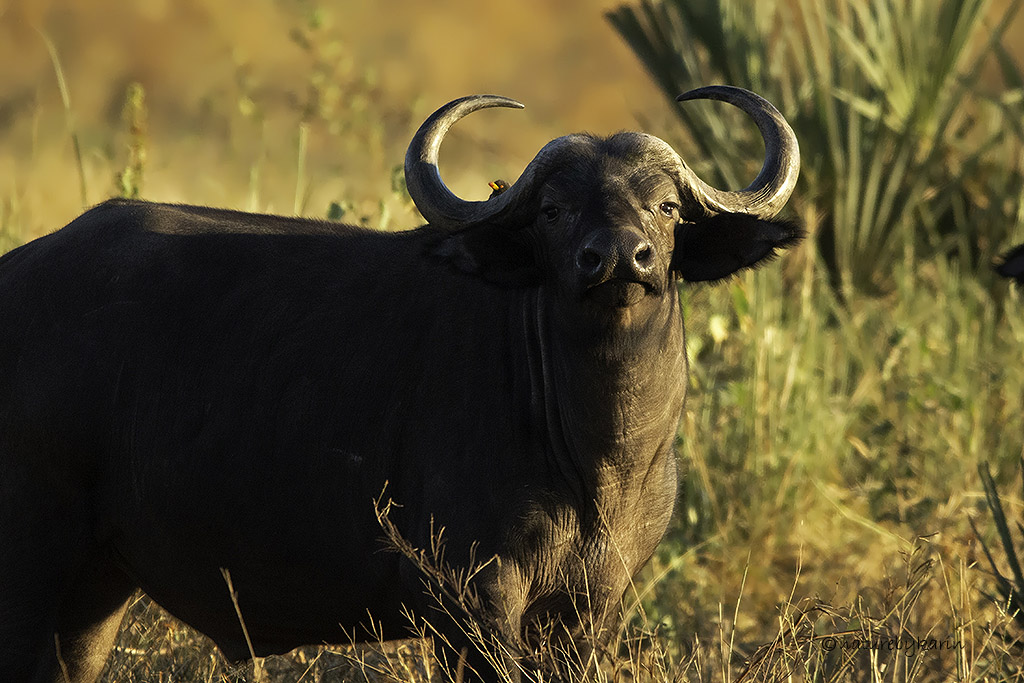
They were soon forgotten however when our reliable guide spotted the little birds that call these palms home – a few Lemon-breasted Canaries! The closest birds were a mom and youngster, but sadly on the wrong side of the light.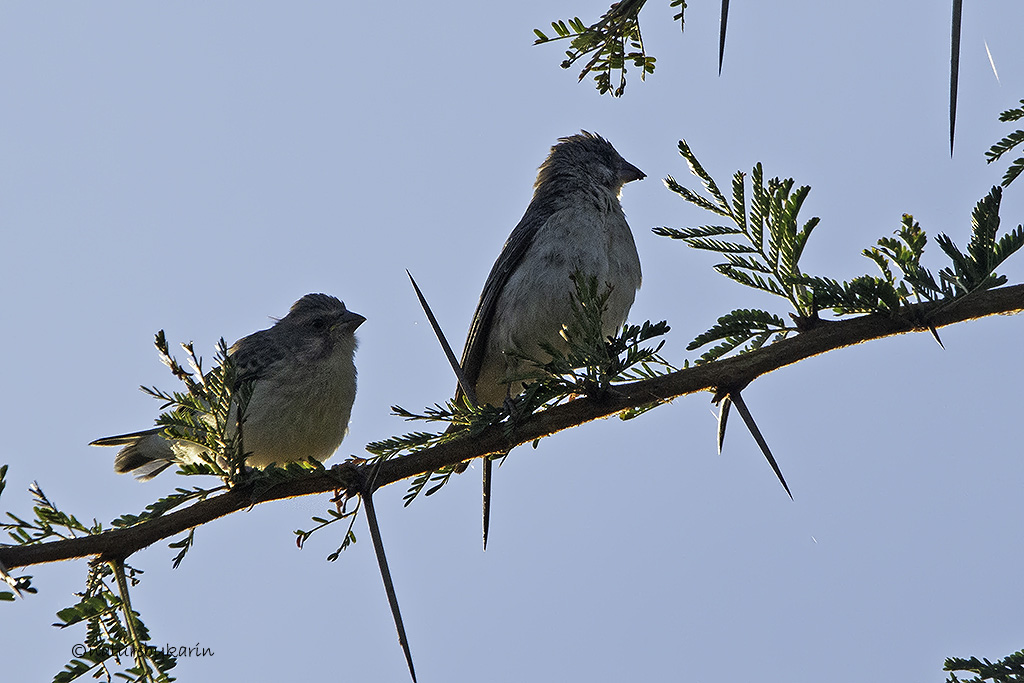
Mom gave the little one a quick breakfast before they flew off. Another one of these cute little birds perched on one of the palms some distance away.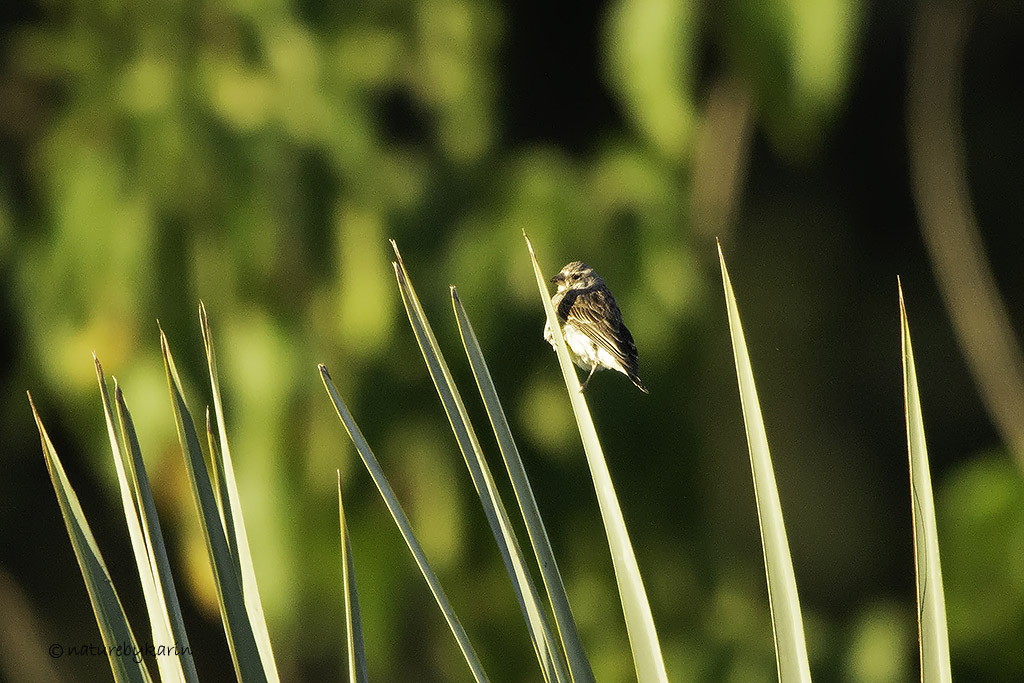
Everyone was extremely excited to see these difficult to find little birds.
The north of Kruger had many Baobab trees. I loved the trees that looked like twins.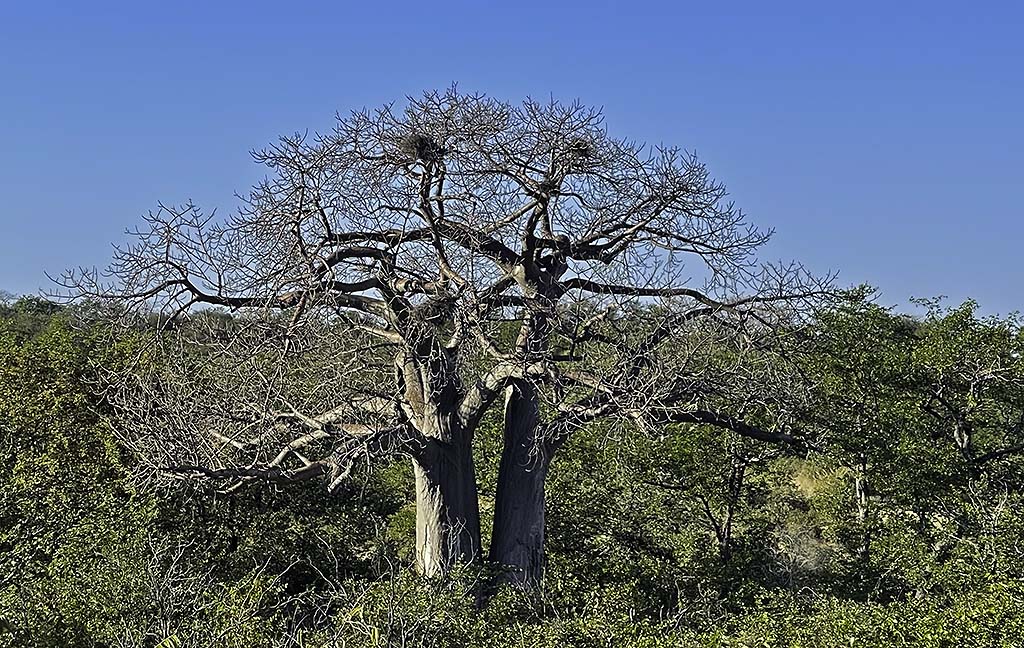
Just before we reached Banyini Pan a young African Hawk-eagle flew past followed not long after an adult. I think I saw more African Haw-eagles on this trip than all previous trips combined.
I also had a brief glimpse of a Tropical Boubou.
Then we reached Banyini Pan. We stopped at the southern end of the pan for a while and I was able to add my last two lifers of the trip – first a stealthy Racket-tailed Roller that was watching us without us knowing from a tree right next to our vehicles. Just as someone spotted him, he flew off, and only allowed me a long distance and blurry record shot. At least he continued the trend of most of my lifers on this trip!
As we were heading back to the vehicles, we also saw Grey-rumped Swallows, my seventh and last lifer of the trip.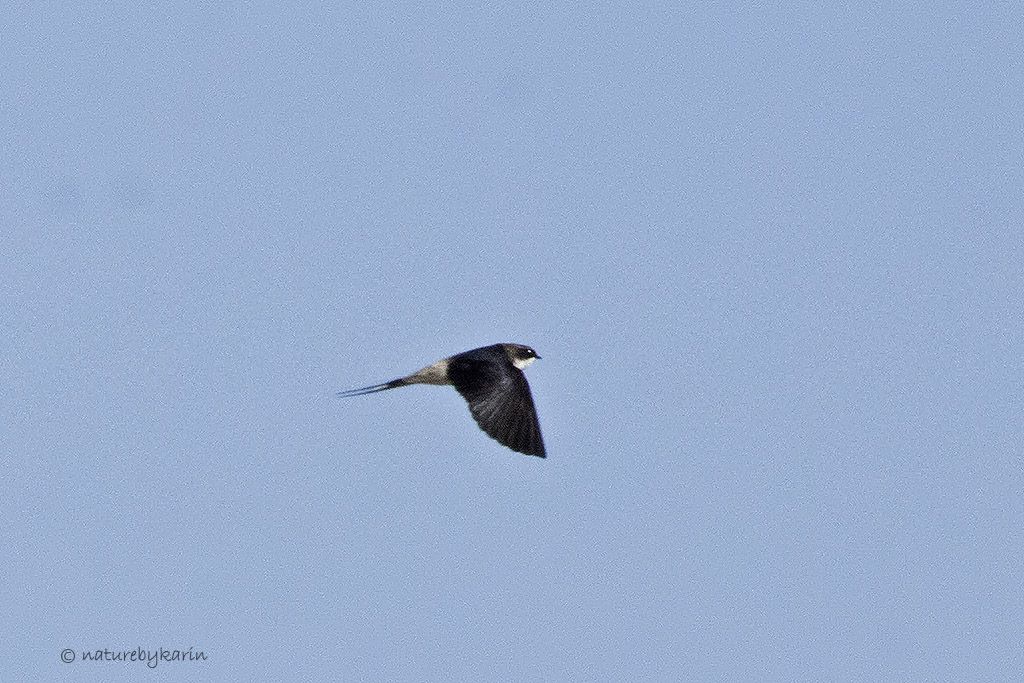
We also had a brief sighting of a couple of Orange-breasted Waxbills, another new Kruger bird for me.
But it was the raptors that stole the show at this particular stop. As we arrived a Lanner Falcon put in an appearance, but we had to use a scope to get a decent view when he perched in a dead tree some distance away.
And then a Martial Eagle appeared in the distance. It wasn’t my first Martial Eagle of the trip. But what made this sighting so spectacular was the fact that there was a Verreaux’s Eagle soaring near the Martial Eagle. I was dumbfounded. Who would have thought that one would ever see two of our most magnificent Eagles together like that? It was one of the stand-out moments of the trip.
That was not the end of the raptor sightings at this beautiful Pan – just as we were about to drive to our coffee spot on the eastern side of the Pan, a Black-chested Snake Eagle flew past!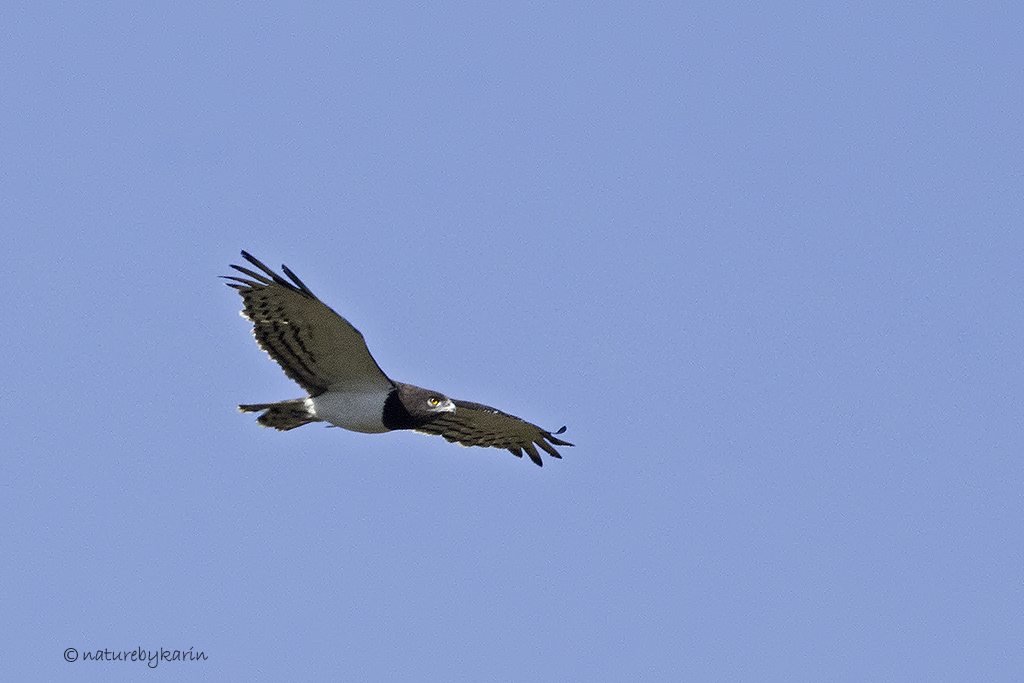
We reached the eastern end of the Pan where we would have coffee. The view was spectacular.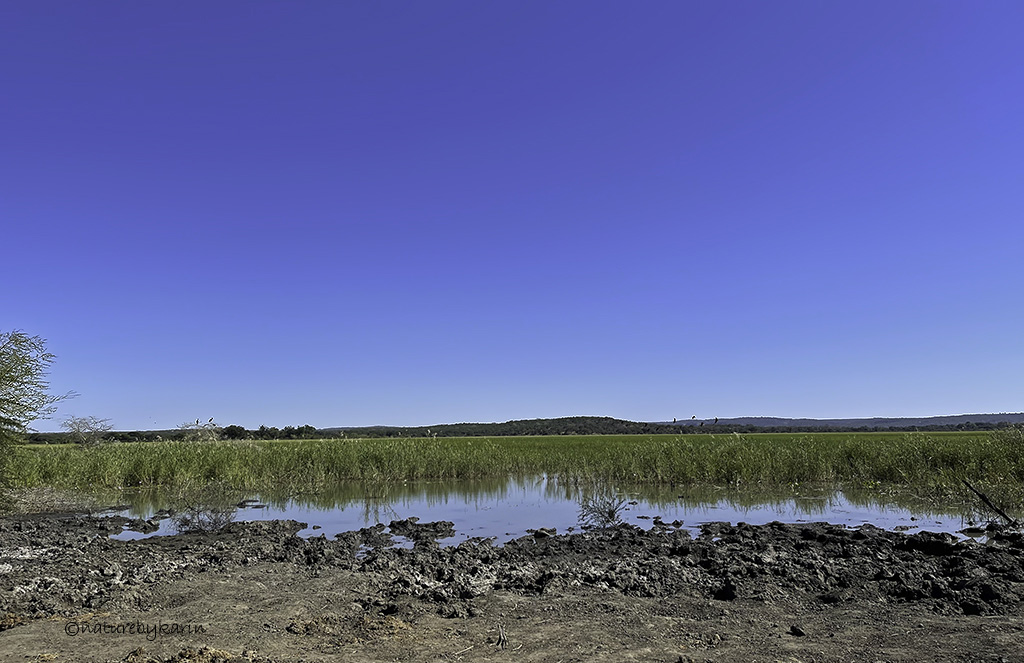
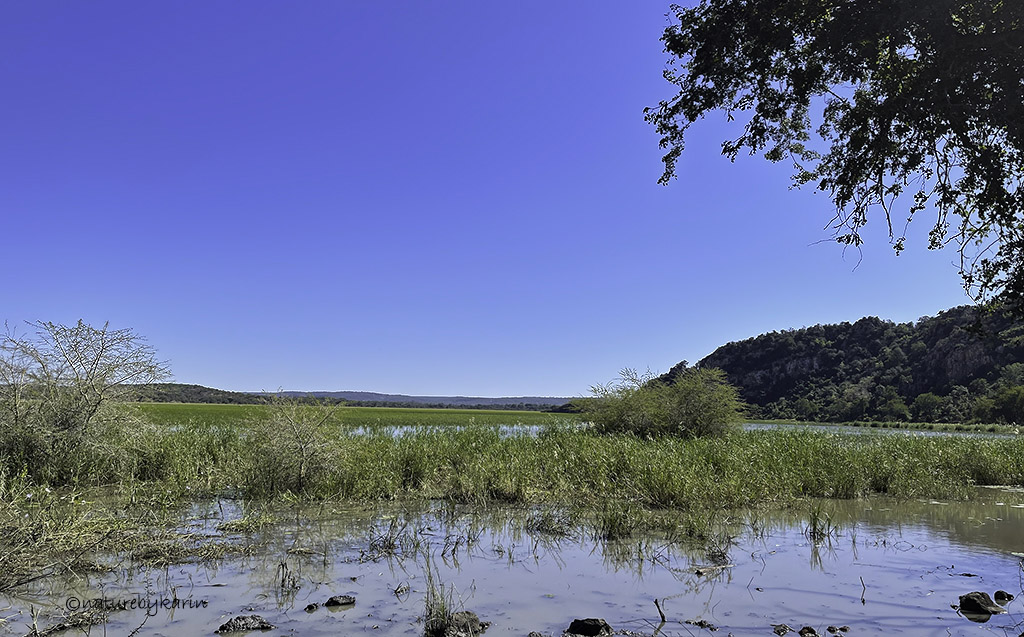
The White-faced Whistling Ducks did not seem to be bothered by our presence at first, but when we walked closer to see if we could spot what sounded like a Lesser Moorhen Calling, they quickly flew off.
There were more Open-billed storks, Cattle Egrets and a Goliath Heron. Around the corner we found a sneaky Dwarf Bittern that only became visible when he flew a few meters. Knob-billed ducks flew past and we saw some Pied Kingfishers. Another highlight was a White-backed Duck that flew past on the other side of the pan, displaying the reason for its name quite clearly.
There were also a few dragonflies hovering around – a Broad Scarlet and a Skimmer.
Another butterfly for my list was a stunning Foxy Charaxes. 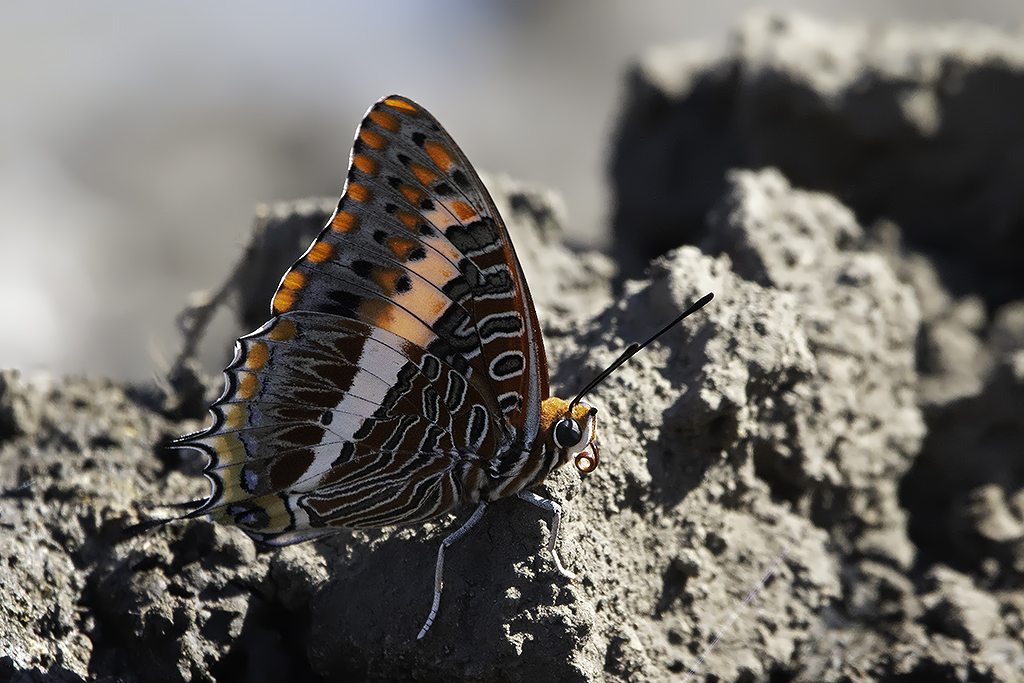
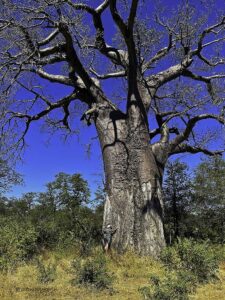 On our way to the Pan I had seen a magnificent Baobab tree very close to the road, and on the way back I asked if we could stop to allow me to do something I have wanted to do for a long time. I was able to give this giant creature a hug. Leaning against the wider than wide trunk and looking up, up, up into its branches was very special and incredibly humbling. It makes you realise just how small you are. I wondered about all of the things that this giant had seen in its lifetime. I imagine the stories it could tell will be fascinating!
On our way to the Pan I had seen a magnificent Baobab tree very close to the road, and on the way back I asked if we could stop to allow me to do something I have wanted to do for a long time. I was able to give this giant creature a hug. Leaning against the wider than wide trunk and looking up, up, up into its branches was very special and incredibly humbling. It makes you realise just how small you are. I wondered about all of the things that this giant had seen in its lifetime. I imagine the stories it could tell will be fascinating!
Another delicious brunch awaited us back at camp. We had a couple of hours to ourselves until the afternoon drive. I sat on the porch of our tent for a while and updated my bird list and my trip notes. But as usual I could not sit still for too long. There was just too much to see and not enough time left.
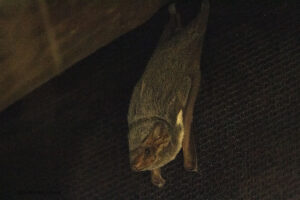 I went to look for the Mauritian Tomb Bat. It was very dark under the roof of the tent, but I can tell you that this little guy is one of the cutest creatures I have ever seen. As I approached, it retreated around the side of the tent. The way it moved was so cool. He scurried sideways almost like a grab. It kept its body flat against the side of the tent and managed to move incredibly quickly. It was absolutely adorable.
I went to look for the Mauritian Tomb Bat. It was very dark under the roof of the tent, but I can tell you that this little guy is one of the cutest creatures I have ever seen. As I approached, it retreated around the side of the tent. The way it moved was so cool. He scurried sideways almost like a grab. It kept its body flat against the side of the tent and managed to move incredibly quickly. It was absolutely adorable.
There was a pair of Village Indigo Birds foraging around and a couple of cute little Blue Waxbills feeding next to one of the tents.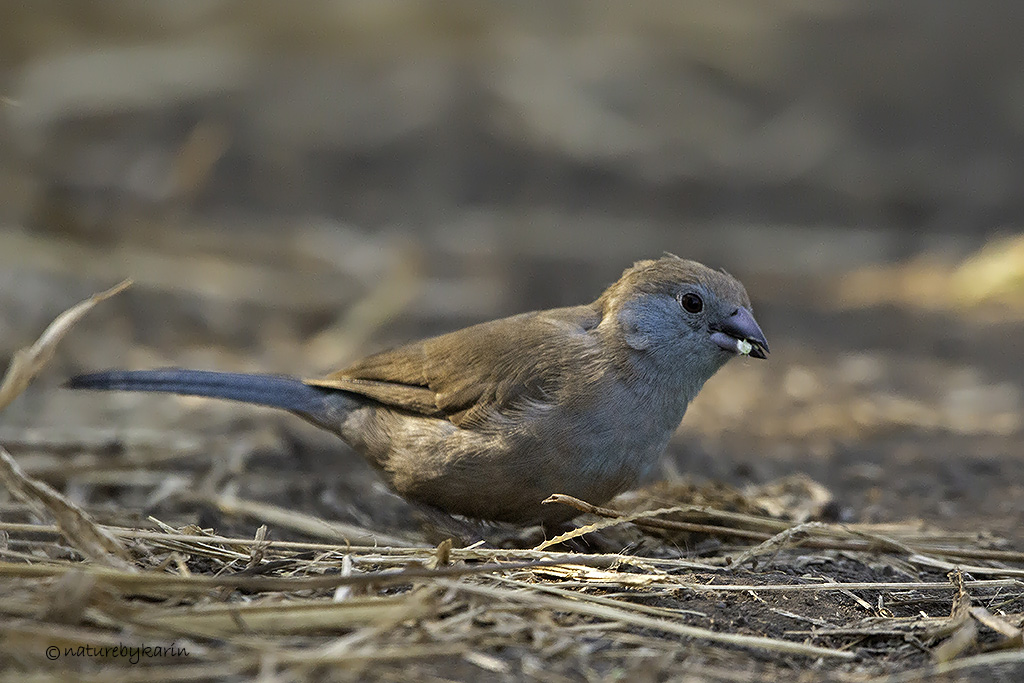
Another butterfly was added to the list – a Green-marbled Skipper.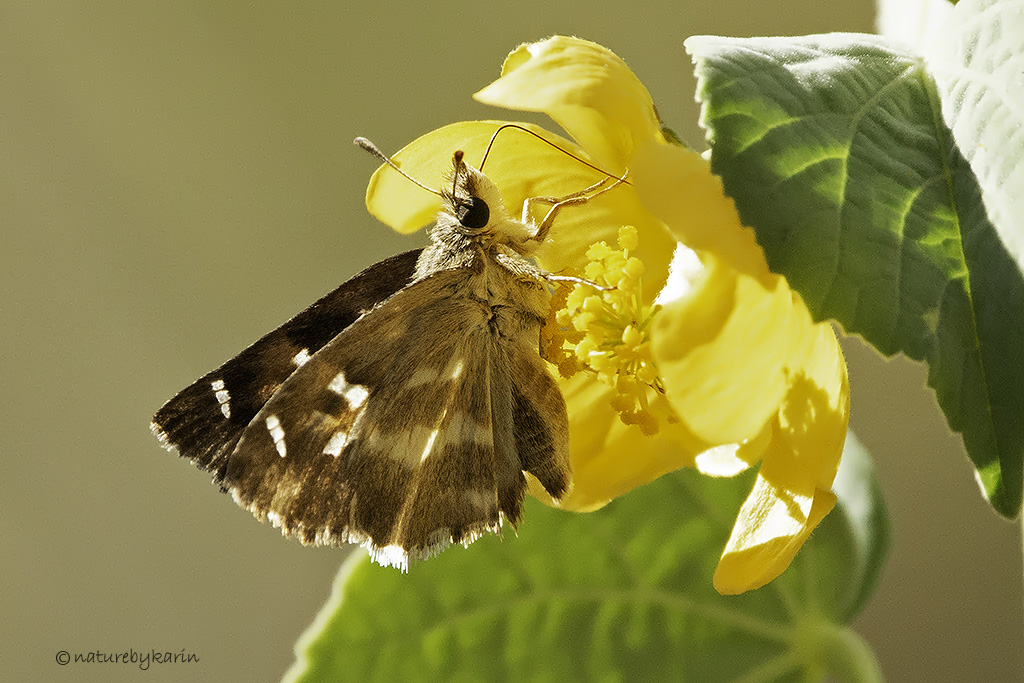
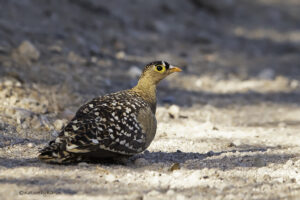 Soon it was time to leave on our afternoon drive. Shortly after leaving camp we came across this Double-banded Sandgrouse. We followed the road north, and the vegetation changed quite a bit. In the forest area we heard the distinctive call of the Gorgeous Bushshrike. There were two of them, but as hard as we tried, we only had very brief glimpses of these birds, but enough to see the beautiful red throat of the male.
Soon it was time to leave on our afternoon drive. Shortly after leaving camp we came across this Double-banded Sandgrouse. We followed the road north, and the vegetation changed quite a bit. In the forest area we heard the distinctive call of the Gorgeous Bushshrike. There were two of them, but as hard as we tried, we only had very brief glimpses of these birds, but enough to see the beautiful red throat of the male.
We speculated whether the hole in the tree was the Red-billed Oxpecker’s nest.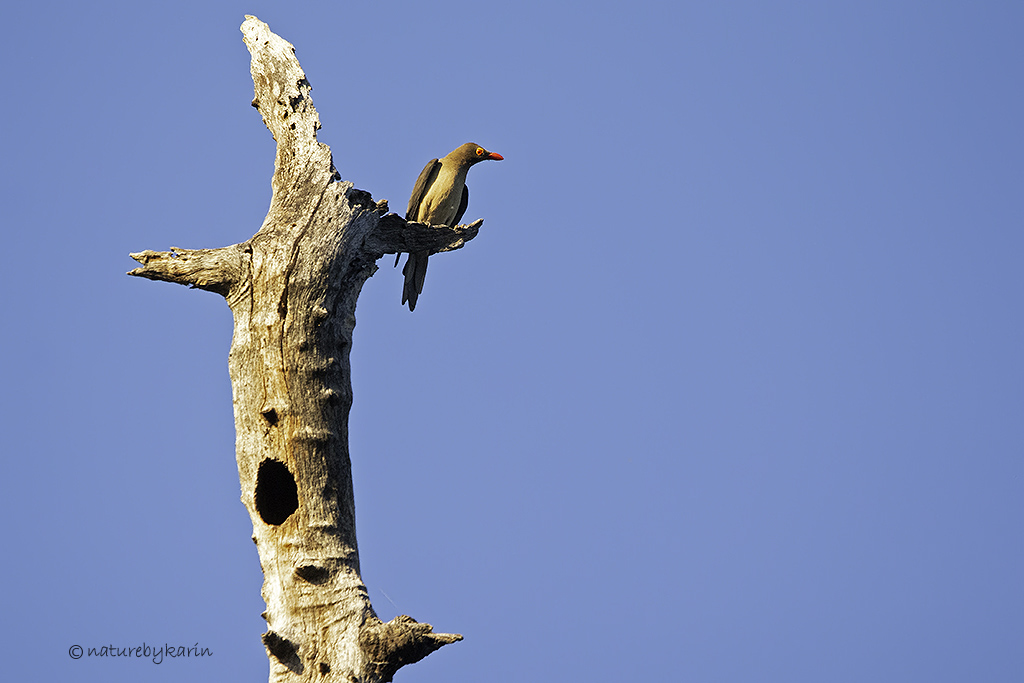
We stopped next to the road and walked the few meters to the banks of the Limpopo River. The sunset was spectacular.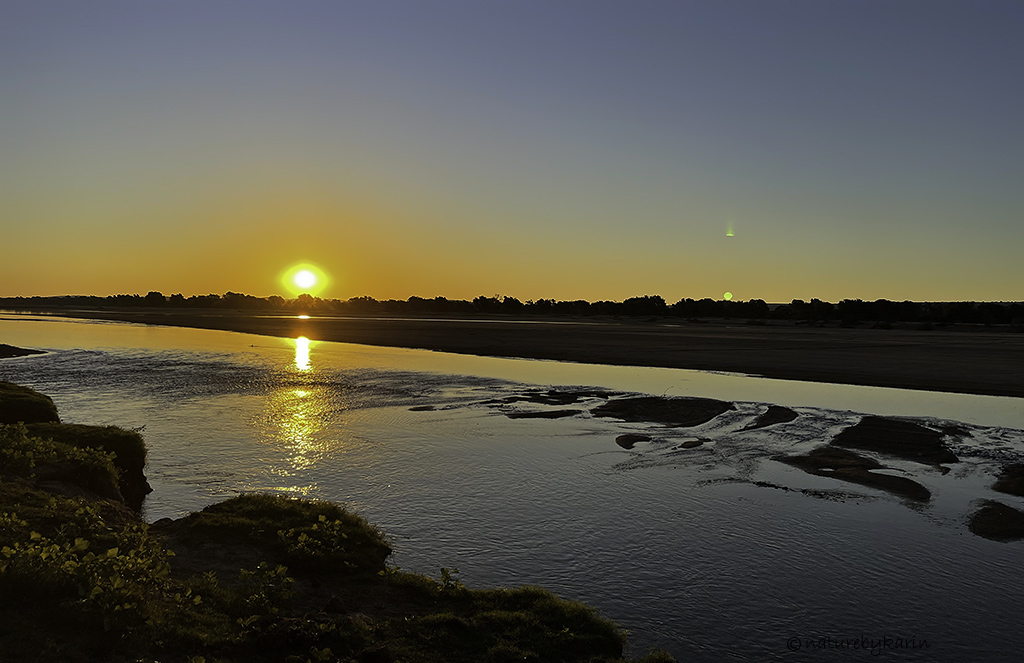
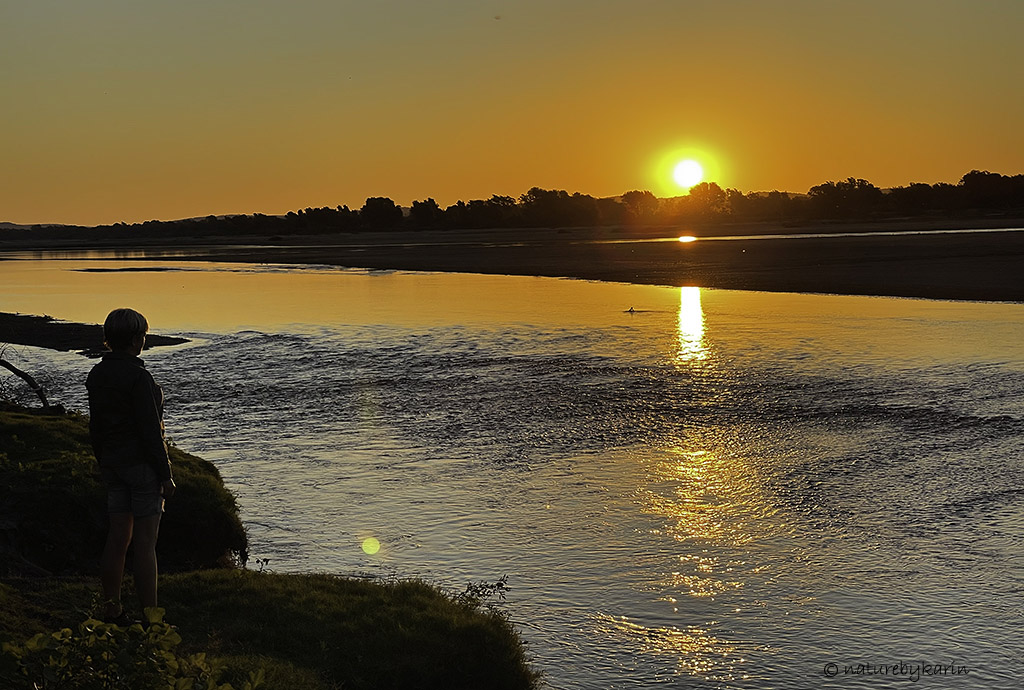
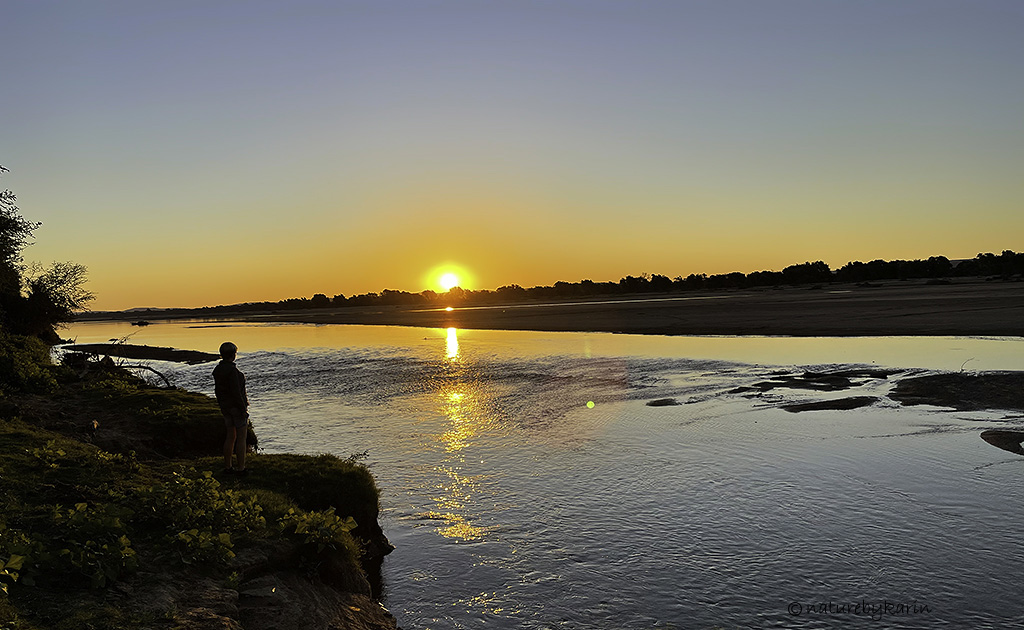
It was an incredibly peaceful afternoon. The quiet chatter of our group added to the atmosphere of the moment. I could not think of a more perfect way to spend our last evening in the magical place. As darkness descended, we reluctantly made our way back to the vehicles.
The guys in the front vehicle spotted one of the finds of the day – a very sleepy Flap-necked Chameleon.
A little further we stopped again to listen to the night sounds. It is hard to describe what it feels like to be sitting in this isolated part of the Park in total darkness with the haunting sounds of a Wood Owl calling beyond the trees. This experience complimented the earlier magic of the sunrise perfectly.
The soundtrack for our last night was not the usual hyenas, but rather the barks of a nearby troop of baboons. I had no idea what disturbed their sleep, but they did not appreciate it!
The next morning I was the first at the vehicles, and while I waited for the rest of the group, I enjoyed the morning sounds. The black sky charted changing to a light grey. And there was a beautiful soundtrack accompanying the start of the day – I heard a Fiery-necked Nightjar as well as a Pearl-spotted Owlet calling. It was magical.
Our last morning had a slightly earlier start than normal because we wanted to see the Red-billed Queleas leave the areas where they roosted at a nearby pan. This may sound strange – why would we want to leave early to see a little bird that is not considered to be a trip special?
If you watch these videos you will understand why this was something we needed to be seen.
Thousands upon thousands of these guys flew over our heads in huge swarms, twittering all the way. I have never seen or heard anything like this before.
I had already seen some of the most beautiful scenes, but this morning unbelievable. The sight and sound of these large flocks of birds is hard to describe. And just as I was able to catch my breath, the sunrise hit me for a six.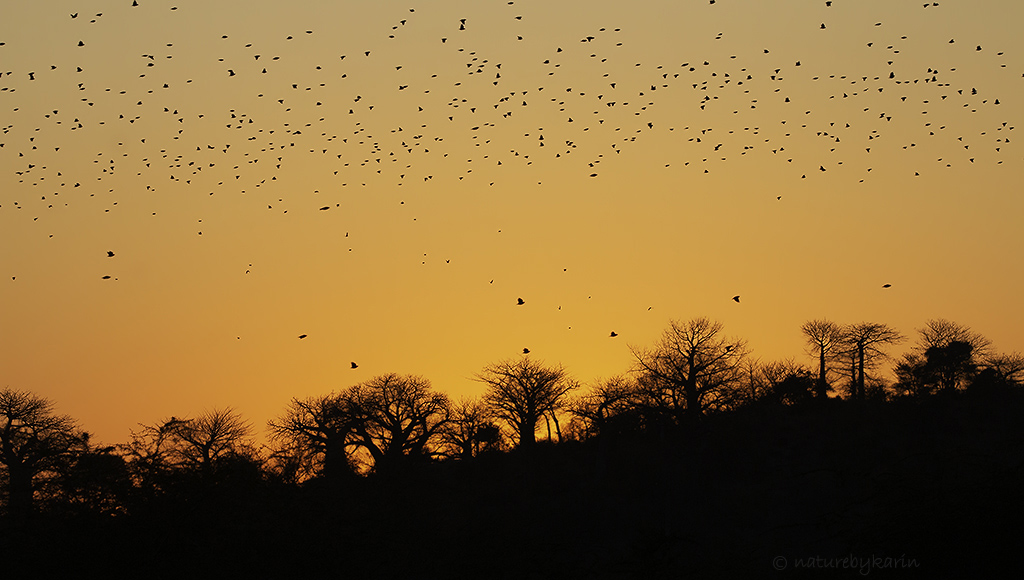
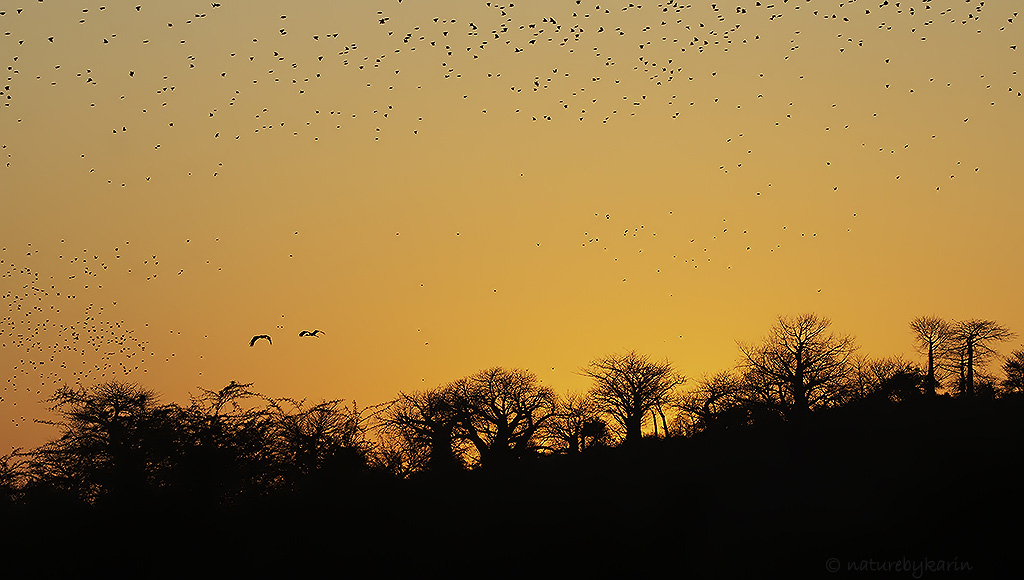
The silhouette of a row of trees, including my favourite Fairytale trees created a scene unlike anything I’ve ever seen.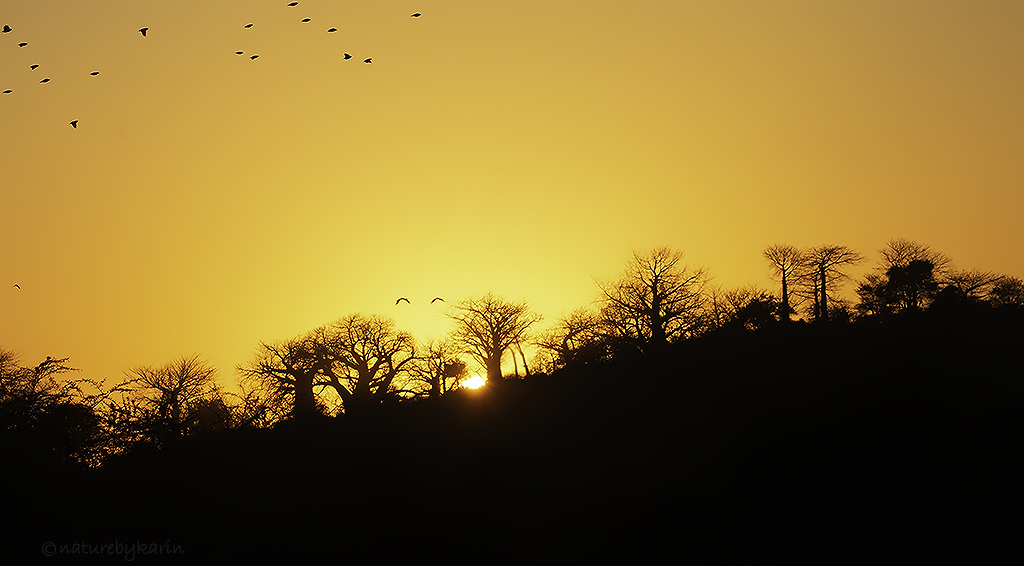
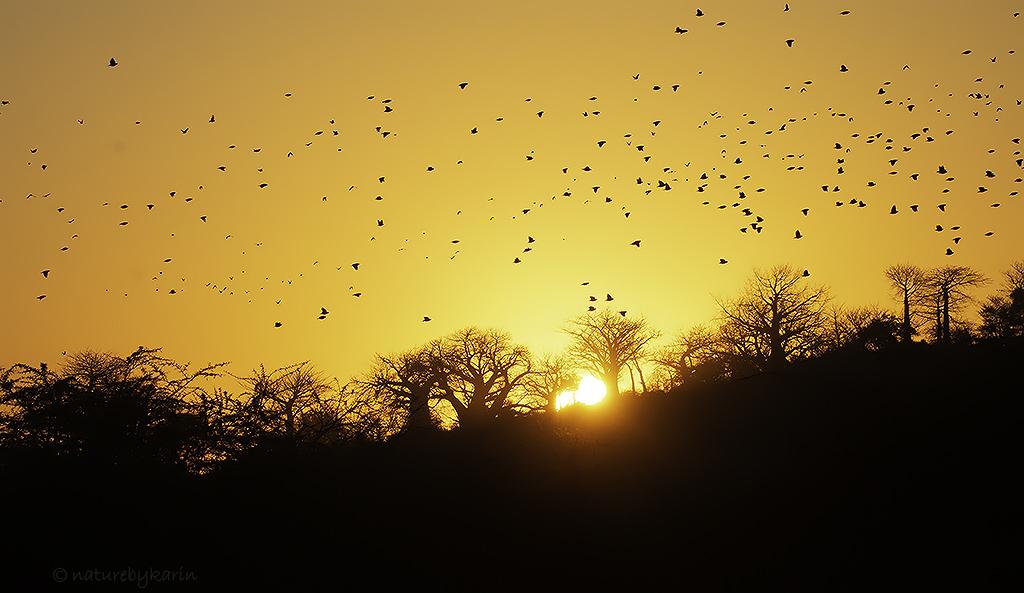
I had to walk away from the group because all of the emotions of the last few days spilled over and I could not hide the tears in my eyes.
The Covid-19 situation caused some doubt whether I should come on this trip. But looking at this glorious sunrise I was incredibly grateful that I was there.
It took a few minutes to compose myself. With a cup of coffee in hand I started walking around the immediate area where we were parked.
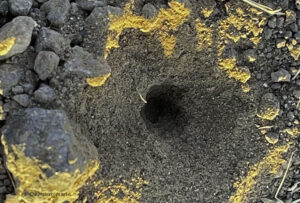 On the side of the road I spotted a row of ant lion homes. I only recently discovered what these guys turn into in their adult form and was absolutely amazed.
On the side of the road I spotted a row of ant lion homes. I only recently discovered what these guys turn into in their adult form and was absolutely amazed.
One of the other ladies pointed out this little burrow. Ross confirmed it was made by a Solifuge.
I asked him about a number of little hollows I saw in the area – it looked like something that could have been created by a bird dust bathing. He confirmed that the size of the hollow and the track we saw is probably an indication that is was made by a Harlequin Quail.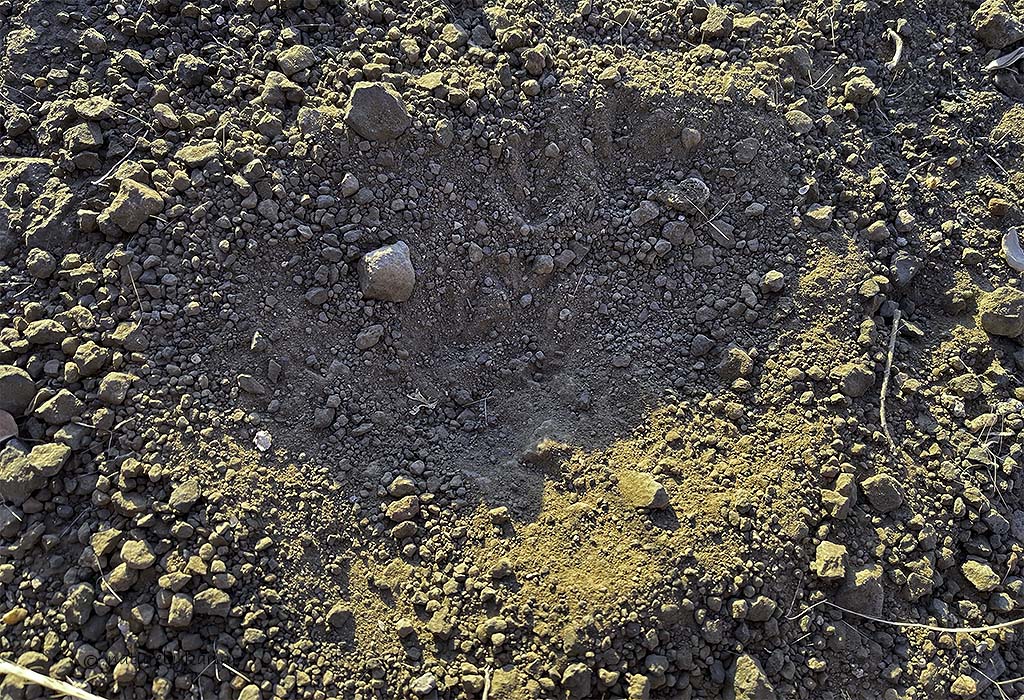
It really is amazing what signs of the bush you can find when you walk around. And then it was time to head back to camp for the last time. On the way we spotted a Brown Snake Eagle in a tree with a Fork-tailed Drongo showing just how much it disliked the bird’s presence. 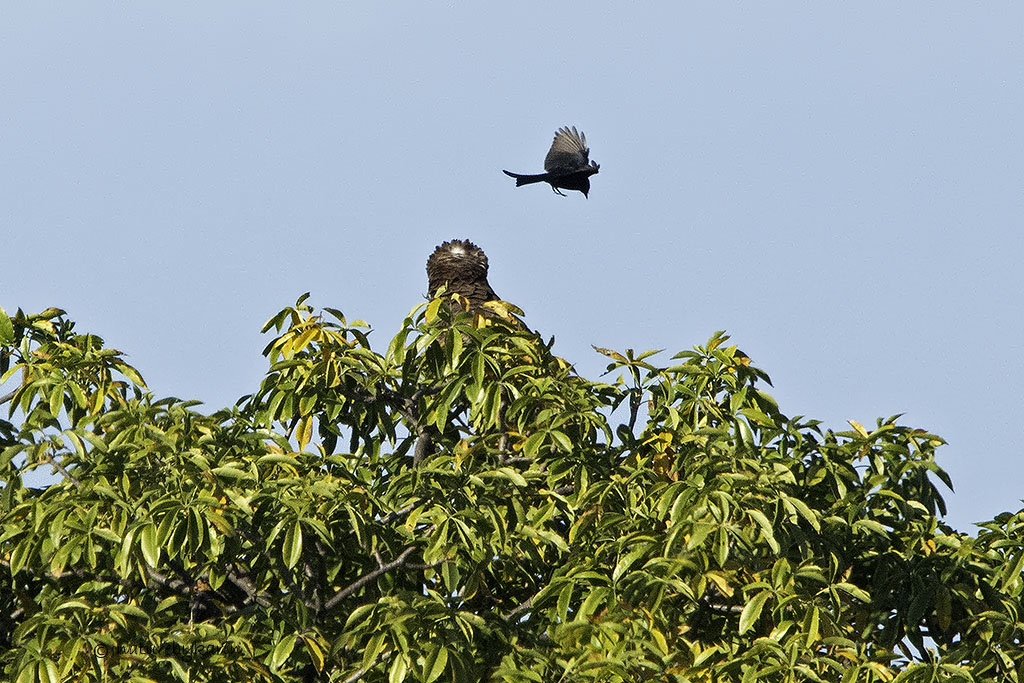
We also saw a Striped Kingfisher, and our friendly neighbourhood Pelican was at the same pan as before.
We had a quick brunch back at camp. This cute little Tree Squirrel joined us.
Then it was time to pack the vehicles, and started the drive back to the Pafuri gate. Ross stopped to show me the Baby Baobab Tree next to the road. How cute is this little guy!
Even though I still had two nights at Punda Maria before I went home, I was rather pensive on the rest of the drive. I think I may have sold both my kidneys right there and then if it meant I could spend more time in Makuleke!
We arrived at the gate and soon everyone had said their good-byes, and all headed off in their various directions.
With everyone heading out of the Park, I was very grateful to be heading back into the Park.
